
|
Below are recent blog posts...
This past weekend I had the honor of speaking at the WHN! Expo in Carbondale, Illinois. I chose the topic of digestion and worked really hard to make a 1 1/2 hour class 45 minutes long, talk about challenges!
I’ve decided to share a few of my favorite digestive blend recipes with my email list. I hope you find them useful!
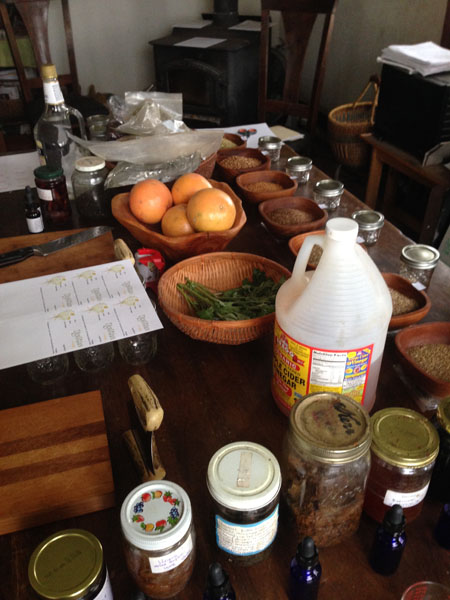
Digestive Blend Salad
What if your food could be your medicine? Well, it can. And it may surprise you to discover that the herbs in your kitchen cabinet all have medicinal uses too!
This salad combines a myriad of digestive herbs to make a delicious digestive salad.Depending on the time of year, some of these may be easier to find than others. Spring is a great time to have an abundance of these plants growing in your back yard but there are still some of these growing right now for us.
Proportions are not extremely important, just think about the properties of the plant as you pick and add them in. For instance, Dandelion leaves are a bit bitter so you might not want to add as many leaves as the rest.
Digestive Blend Salad
Dandelion leaves (and flowerheads shredded if they are blooming)
Peppermint or spearmint leaves
Lemon balm leaves
Fennel leaves
Chickweed (aerial parts)
Violet leaves and flowers (when in season)
Plantain leaves
Calendula flowers
Marshmallow flowers
Mix together and serve with an infused oil and vinegar dressing of your choosing.

Digestive Tea Blend
This tea is a great tea any time of day. It is warming, a bit spicy (add more pepper for a spicier blend) and delicious. Finish with some honey and cream for a truly decadent tea.
In a jar combine:
1 cup Roasted Dandelion Root
6 Tbsp Fennel or Anise seed
1 tablespoon green Cardamom pods
1 tablespoon Cloves
6 Cinnamon sticks crushed
2 Tbsp dried Ginger root
1 1 /2 tsp black Peppercorns
12 Bay leaves broken into pieces
Add 1 tbsp mixture per cup of water, simmer for 10-15 minutes then steep for 5-10 minutes.
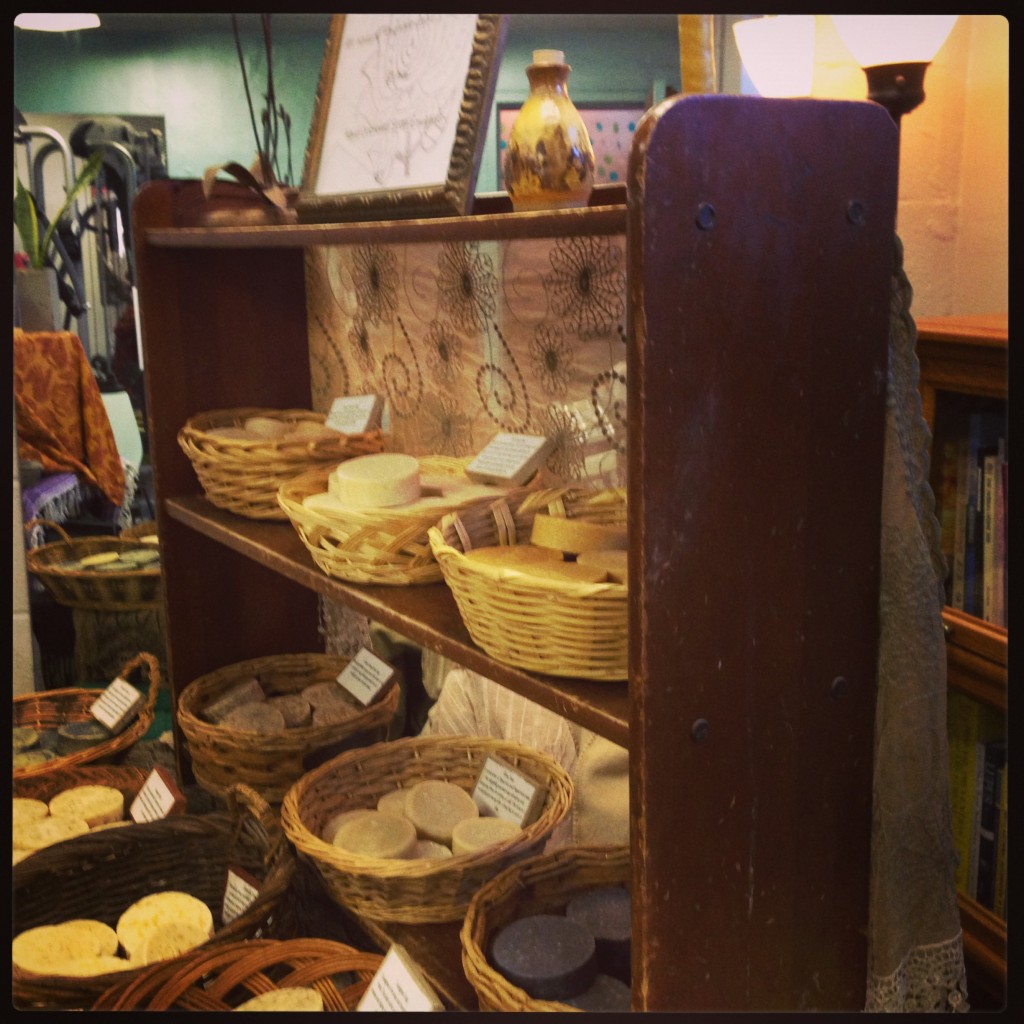
Upcoming events
The Smelly Gypsy will be at the Green Gift Bazaar at the YWCA in Alton, IL on Saturday, November 25, an event put on by the local Sierra Club.
On Saturday, December 9, The Smelly Gypsy will make her last appearance for the year at the Collinsville Library’s Local Artist and Author Market in Collinsville, IL.
Stock up on all your favorite smelly supplies, soaps make great stocking stuffers!

This entry was posted
on Monday, November 13th, 2017 at 8:45 pm and is filed under Uncategorized.
You can follow any responses to this entry through the RSS 2.0 feed.
You can leave a response, or trackback from your own site.
 Medicine Trail Entrance with our UpS Grant Recipient Sign! Starting in April 2015, we began clearing invasives from the western portion of our property with the goal to create a medicinal woodland trail. The area is overrun with bush honeysuckle, trash and debris, neglected from the previous owners. Clearing the debris from this farmette has been an ongoing process over the last 10 years and this is the first year that the possibility of cleaning up this side of the farm became available.
The area is rich with promise, hosting a variety of native slippery elm, elderberry, oak and more. We worked on a third of the trail this year, clearing the invasives, piling them on the western border to create natural habitats for critters and preparing beds for native medicinals to be planted. We also worked to clear out trash that had been left by the previous owners as well as trash that had blown in from the subdivision next door.
At the end of April our first round of medicinal plants arrived: 40 luscious plants, 10 each of: Black Cohosh (Acteae racemosa), Blue Cohosh (Caulophyllum thalictroides), American Ginseng (Panax quinquefolius) and Goldenseal (Hydrastis canadensis) from Companion Plants in Ohio. These beautiful bare roots were quickly settled into their beds and labeled. I also received some Wild Ginger (Asarum caudatum) from a friend which was also planted along the trail.
Mid-May saw the arrival of more plants: 5 False Unicorn Root (Chamaelirium luteum) plants arrived, along with 2 Wild Hydrangea (Hydrangea arborescens). A few days later, 5 True Unicorn (Aletris farinosa) plants arrived and were placed in a sunnier location of our garden. Eventually, they will be incorporated to the beginning of the Medicine plant trail when the beds are prepared accordingly for them.
Our summer provided lots of rain so after the first few weeks, we did not find it necessary to water the plants anymore. The rest of the summer was spent maintaining the area, mostly keeping the honeysuckle from returning.
Most of the plants have gone dormant at this point, nestling down for the winter. We will spend the autumn raking the leaves into the plant beds to provide extra mulch for nourishment and protection during the winter.
Over the winter we will be making signs to place in the beds.
Next spring we plan to double the plants in the beds and add some native Trillium (Trillium recurvatum), Solomon’s Seal (Polygonatum commutatum), Solomon’s Plume (Smilacina racemosa), Mayapple (Podophyllum peltatum) and Bloodroot (Sanguinaria canadensis). We will also begin clearing out the next portion of the trail. It is our hopes to have the trail completely cleared in the next 2 years, opening it to the public for a educational walking trail. In the meantime, we plan to host plant walks to the community starting early next summer for the first portion of the trail.

This entry was posted
on Tuesday, November 10th, 2015 at 6:30 pm and is filed under Uncategorized.
You can follow any responses to this entry through the RSS 2.0 feed.
You can leave a response, or trackback from your own site.

I happily unwrapped and planted the True Unicorn Roots (Aletris farinosa) that arrived today. They look amazing! I got them from Rare Finds Nursery, a nursery that specializes in growing rare plants. You can’t tell from the picture, but the pots were all stapled into the box so that they didn’t crush each other.
For the time being, I am planting them in my main garden where I can keep an eye on them but eventually, they will be moved to the front of the medicine trail once the area is cleared and prepared. Here are a few pictures of the beautiful plants.

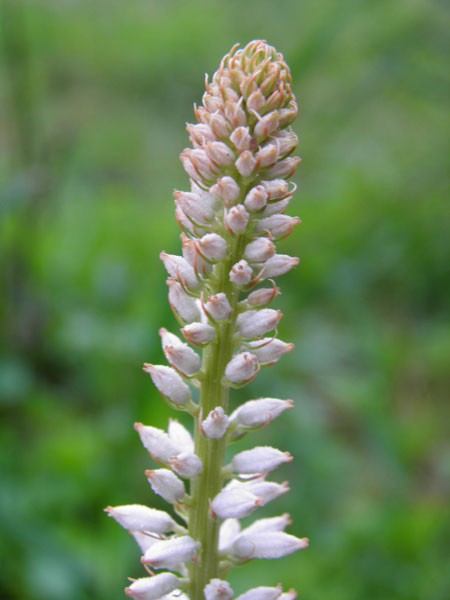


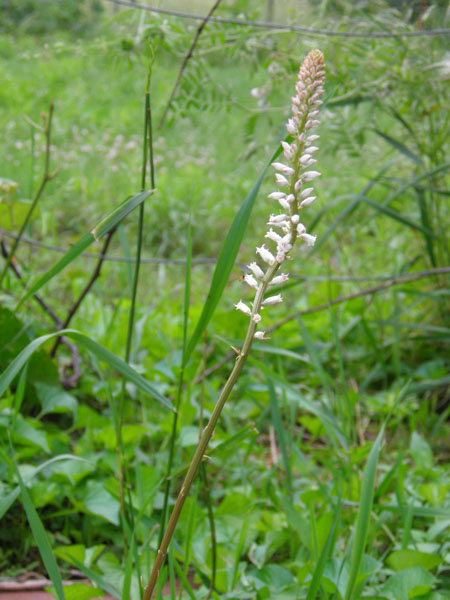
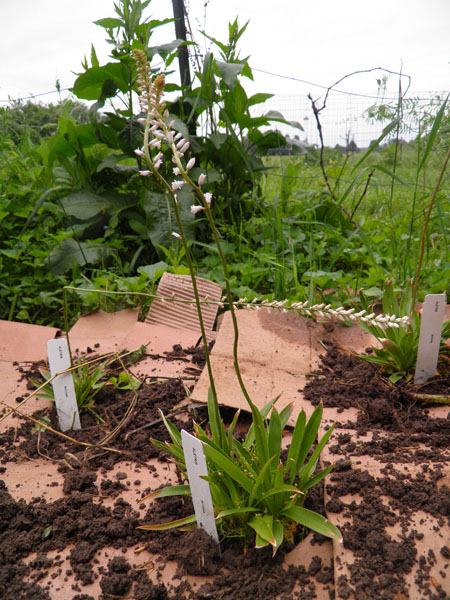

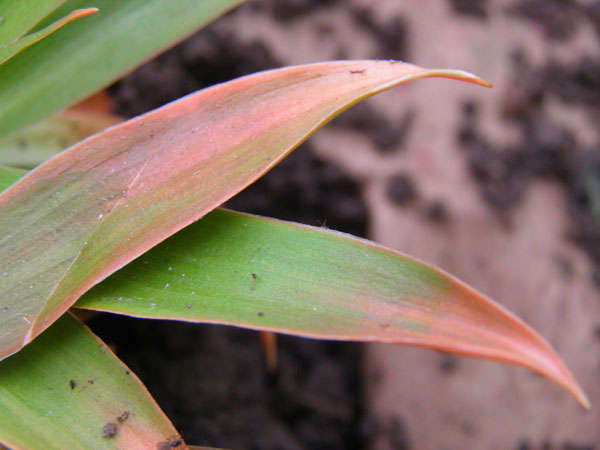

This entry was posted
on Wednesday, June 10th, 2015 at 6:03 pm and is filed under Uncategorized.
You can follow any responses to this entry through the RSS 2.0 feed.
You can leave a response, or trackback from your own site.
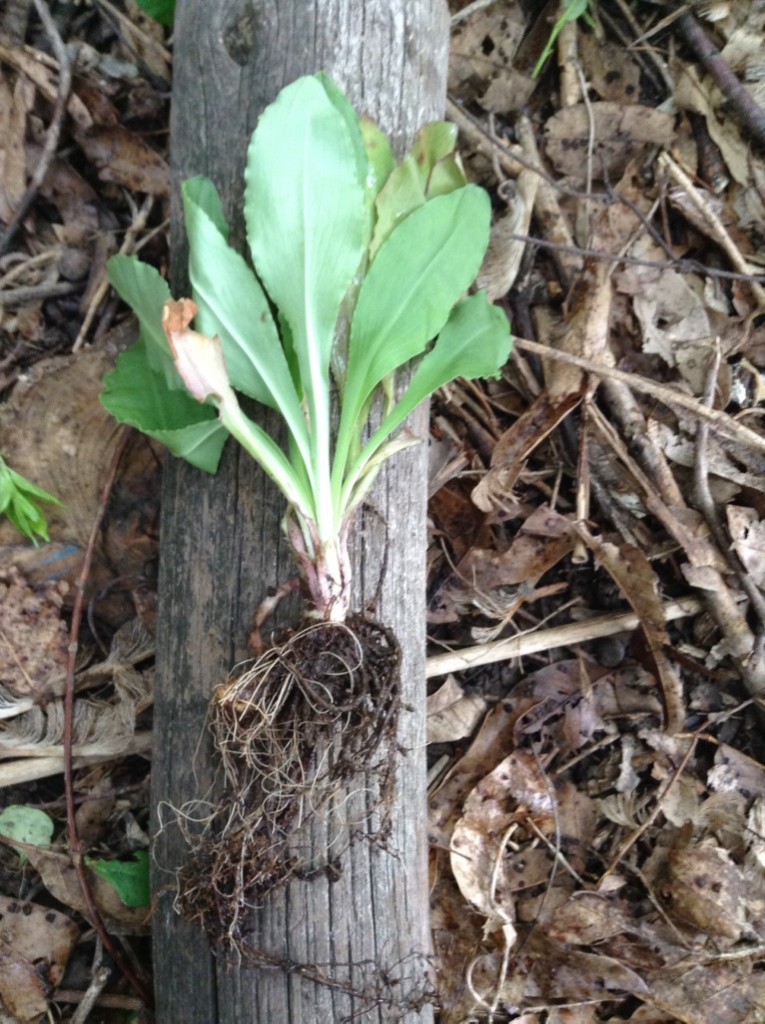
Today 5 lovely False Unicorn Root (Chamaelirium luteum) plants arrived, along with 2 Wild Hydrangea (Hydrangea arborescens). Sadly, it appears the Hydrangea may not have survived the trip but the Chamaelirium looked pretty perky considering their 2 day trip through the mail service.
I immediately planted them out and watered them in. I will be fussing over them like an anxious mama, hoping they will settle in and do well.
Typically I’ve been planting in 2 separate locations to ensure a productive crop but because Chamaelirium luteum is unisexual, I wanted to plant them all together to make sure I have some male and female plants together in the grouping for reproduction.
This is the perfect time for transplanting as we have comfortable temperatures and gentle warming rains to help soak them in.
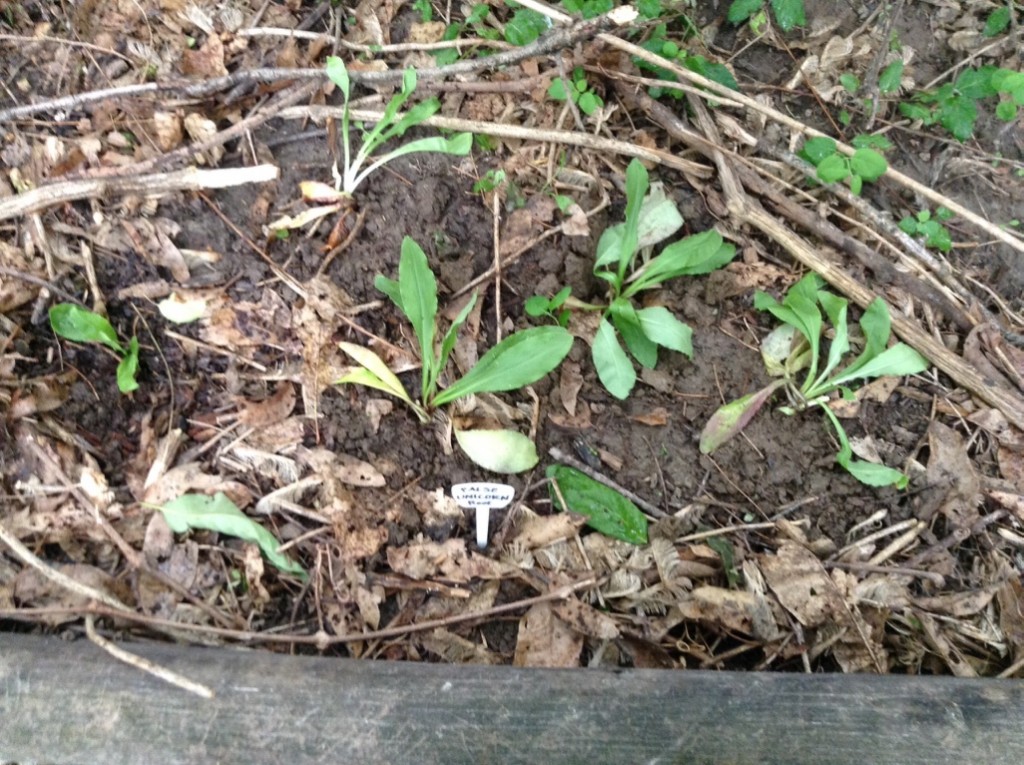

This entry was posted
on Friday, May 15th, 2015 at 10:17 pm and is filed under Uncategorized.
You can follow any responses to this entry through the RSS 2.0 feed.
You can leave a response, or trackback from your own site.

We are excited to announce that we were chosen as one of the 2015 Grant Recipients for United Plant Savers! We will be using this grant money to purchase medicinal plants for our medicinal plant trail that we are creating along the length of the western property line. This trail will be used to encourage our community to learn about native endangered plants and to start cultivating them on their own property.
Stay tuned for updates on the progress of our medicine trail!

This entry was posted
on Tuesday, May 12th, 2015 at 12:32 pm and is filed under Uncategorized.
You can follow any responses to this entry through the RSS 2.0 feed.
You can leave a response, or trackback from your own site.
A bit of rain has been these plants very happy. It’s exciting to walk through the trail and see the daily changes…
Blue Cohosh is flowering!

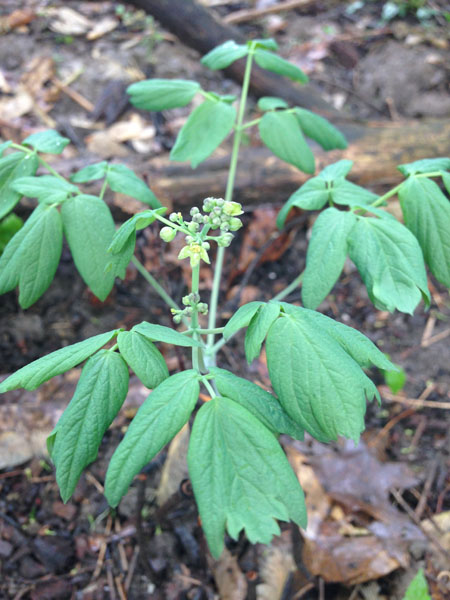
American Ginseng is growing by leaps and bounds

Ginger is perking back up

Black Cohosh is appreciating the rain and emerging nicely

Even Goldenseal has finally started to pop

A Slippery Elm along the trail

The medicine trail entrance is guarded by Grandmother Elder
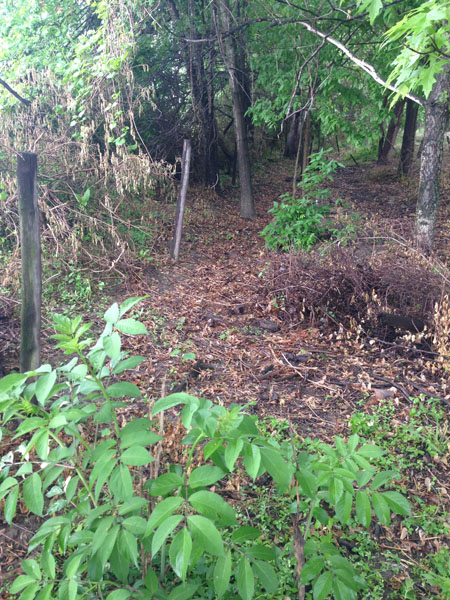
Black Cohosh in another garden bed, seems very happy


This entry was posted
on Saturday, May 9th, 2015 at 10:38 pm and is filed under Uncategorized.
You can follow any responses to this entry through the RSS 2.0 feed.
You can leave a response, or trackback from your own site.
Just a few short days and already plants are popping up!
Blue Cohosh – Caulophyllum thalictroides

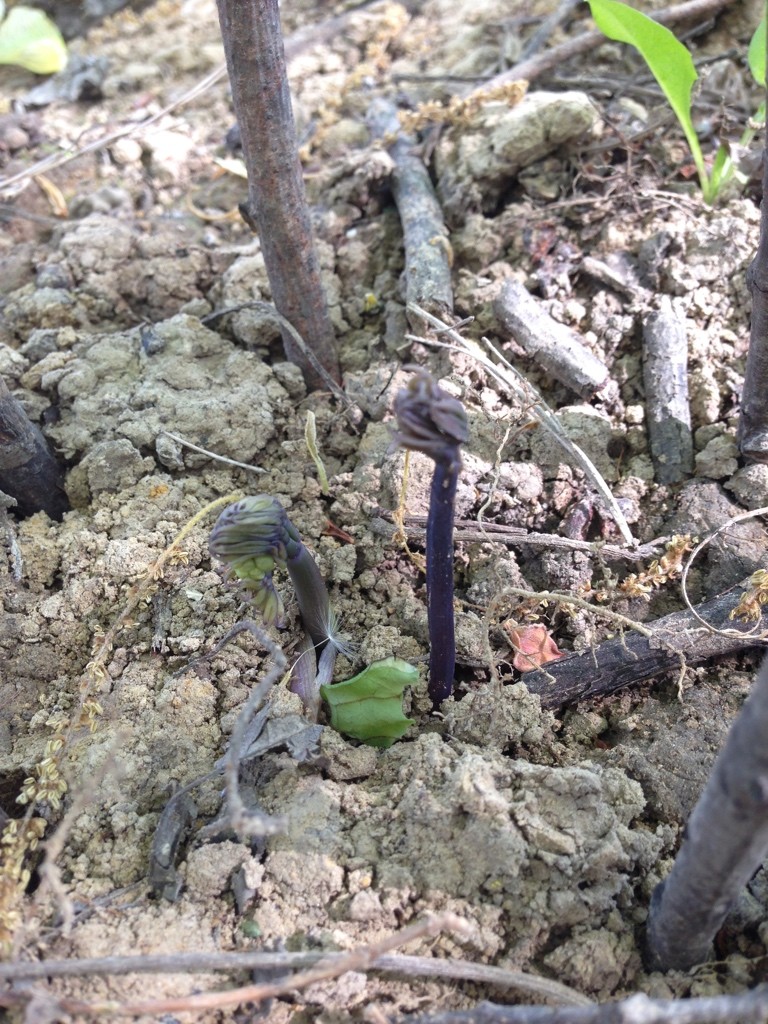
American Ginseng – Panax quinquefolius

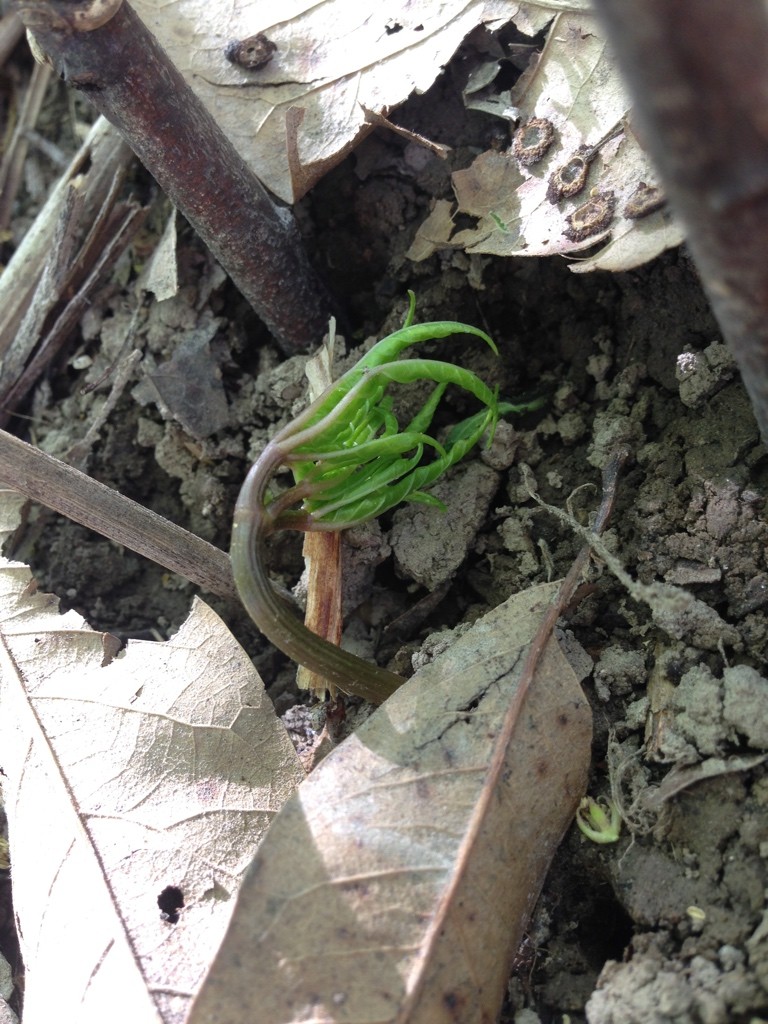
Notice all the stick fence chicken deterrents? Just a few twigs around each tender emerging plant protects them from being snapped by scratching chickens.

This entry was posted
on Friday, May 1st, 2015 at 8:32 pm and is filed under Uncategorized.
You can follow any responses to this entry through the RSS 2.0 feed.
You can leave a response, or trackback from your own site.
My first order for the Medicine trail has arrived, 40 luscious plants, 10 each of: Black Cohosh – Acteae racemosa, Blue Cohosh – Caulophyllum thalictroides, American Ginseng -Panax quinquefolius and Goldenseal – Hydrastis canadensis from Companion Plants in Ohio. I am very pleased with these bare root plants and highly recommend them!
Here’s a glimpse of some of the roots…
Blue Cohosh – Caulophyllum thalictroides

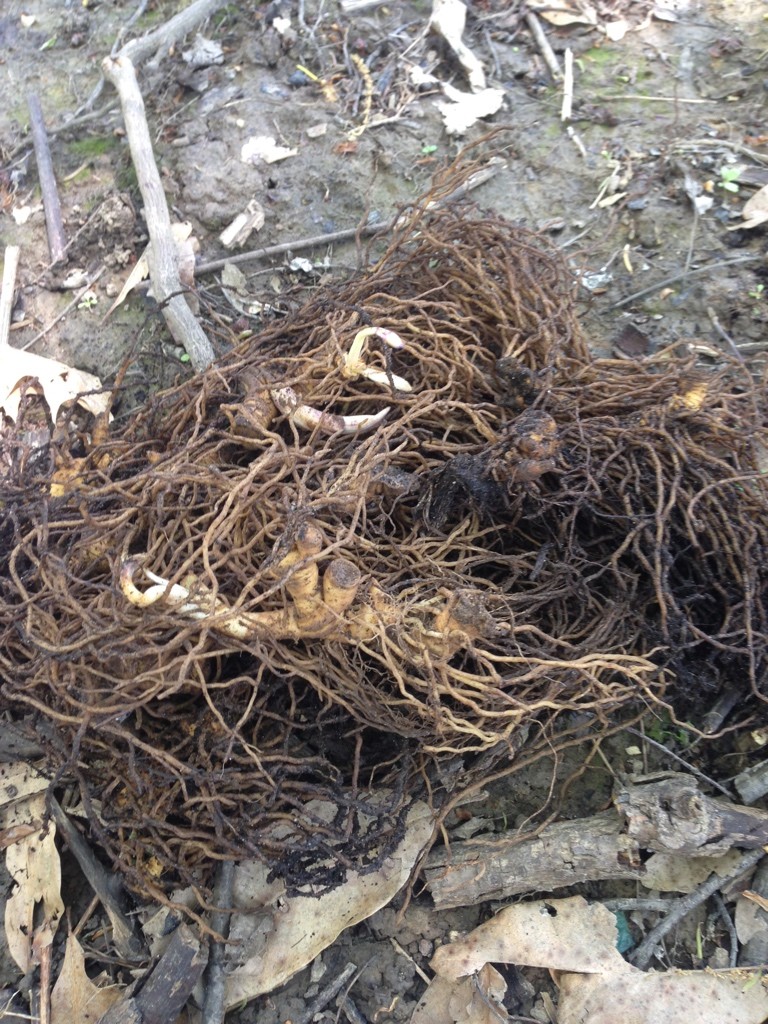

American Ginseng -Panax quinquefolius


Black Cohosh – Acteae racemosa

I was so excited to get them all in the ground that I completely forgot to get pictures of Goldenseal.

This entry was posted
on Sunday, April 26th, 2015 at 7:21 pm and is filed under Uncategorized.
You can follow any responses to this entry through the RSS 2.0 feed.
You can leave a response, or trackback from your own site.
One of my favorite activities is visiting my little plant babies to check their progress. They grow by leaps and bounds every day!
This is what is growin’ on…
Goldenseal is blooming
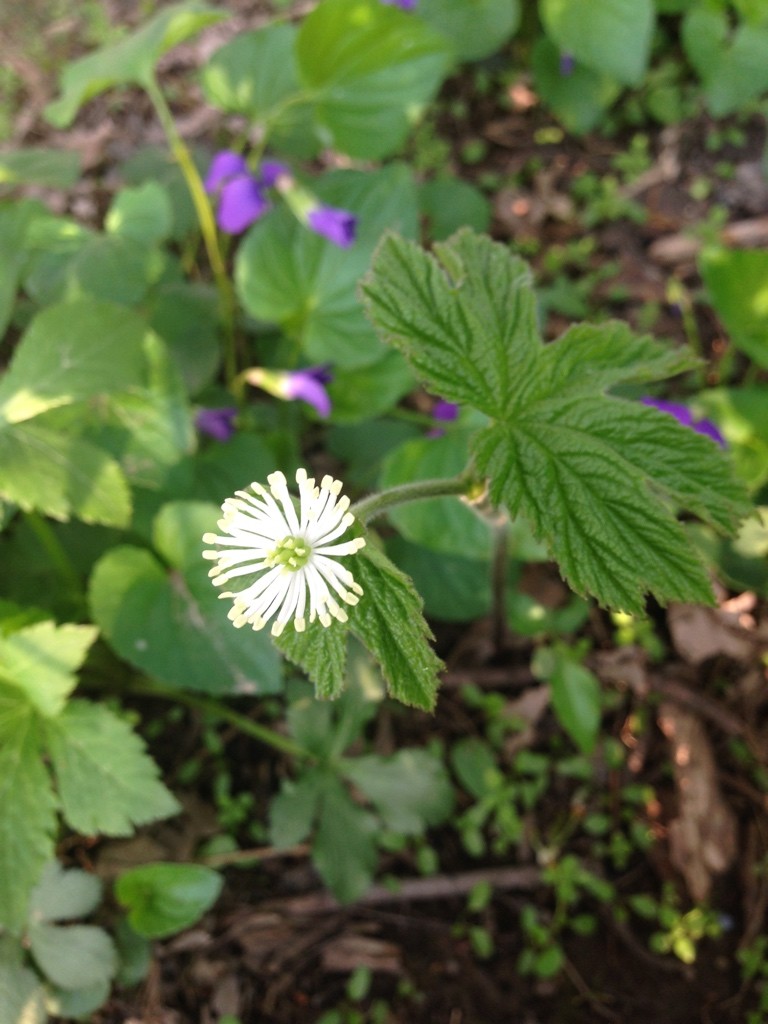 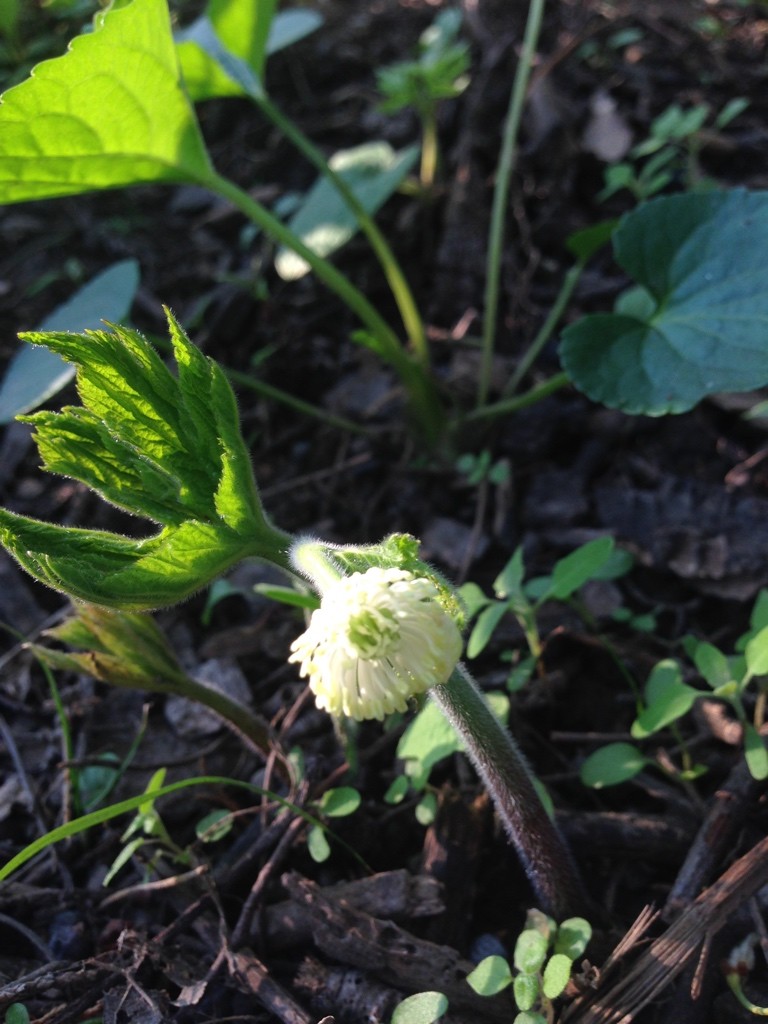
Black Cohosh has emerged…

Celandine Poppies are blooming…
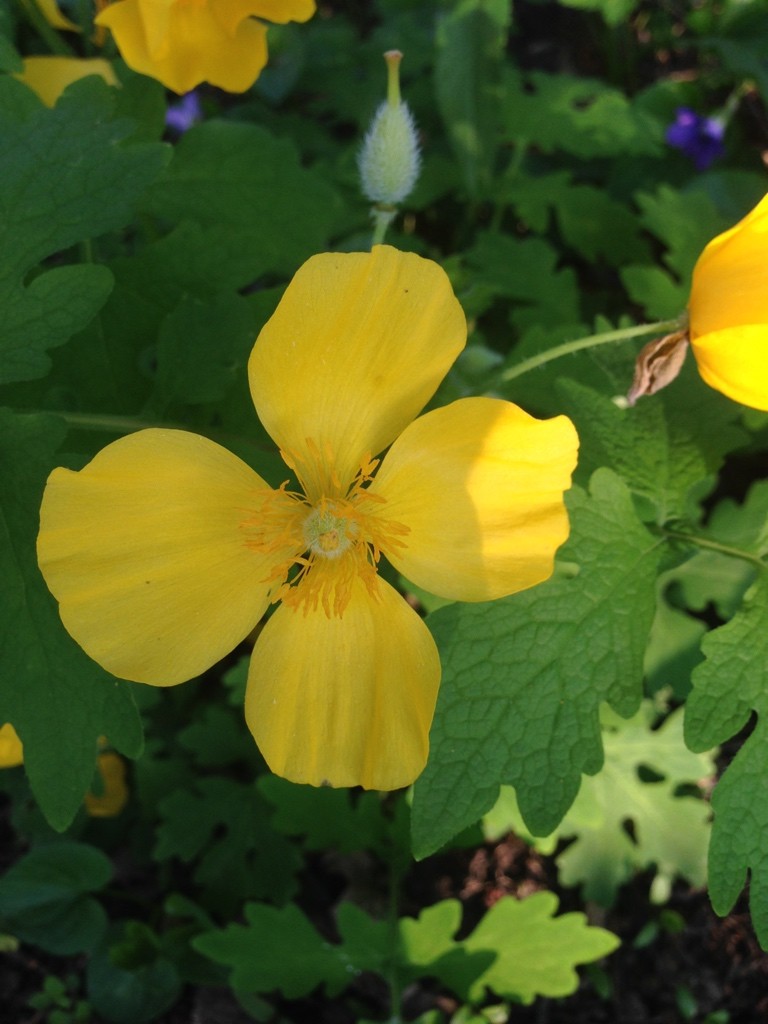
And Trilliums too…

Even the Ginger is but you have to look closely under all those lovely leaves…
 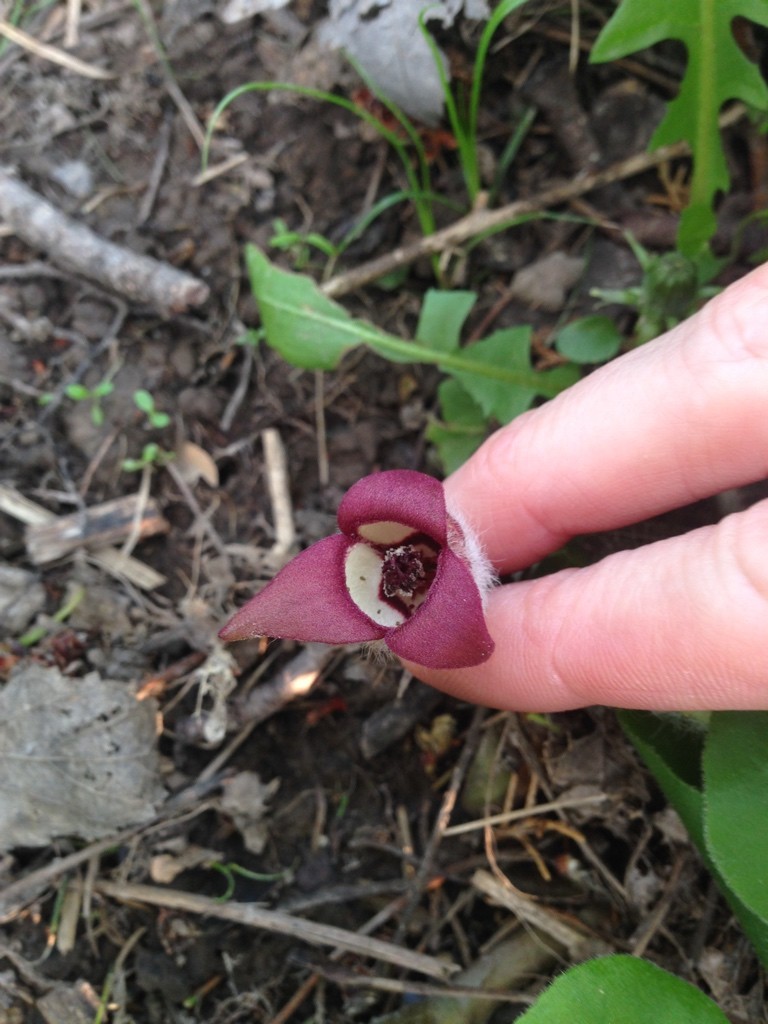
Virginia Bluebells are a childhood favorite of mine

Native Yellow Violets are starting to spread…


This entry was posted
on Saturday, April 18th, 2015 at 1:08 pm and is filed under Uncategorized.
You can follow any responses to this entry through the RSS 2.0 feed.
You can leave a response, or trackback from your own site.
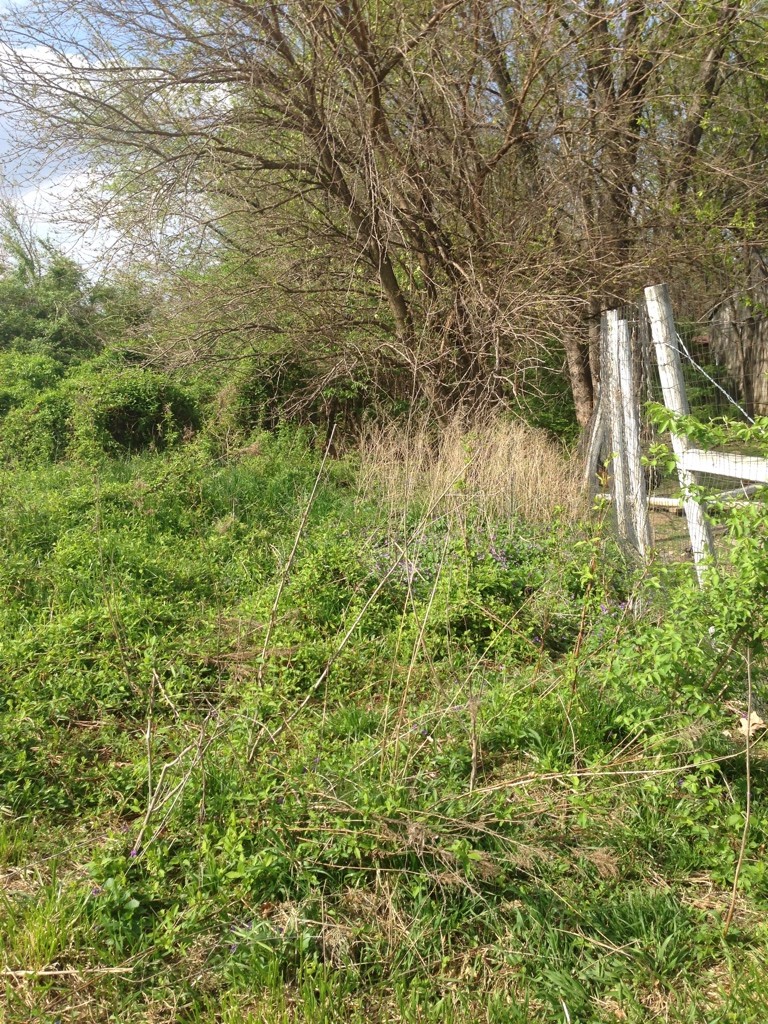 Beyond the Mulberry tree lies a secret trail… New in 2015, this trail runs the length of our property line in a woodland setting. As time and funds permit, we’ll be adding native and medicinal plants, creating a teaching trail for the community to enjoy and learn from. The purpose of this trail is to educate the community, enhance native and endangered plant species, create wild spaces for wildlife to habitat and to cultivate at risk and endangered medicinal herbs.
Currently this medicine trail hosts (we’ll add to the list as we add to the trail and discover what’s growing as we clear out the invasives):
Plants
Stinging Nettles (Urtica dioica)
Shrubs
Elderberry (Sambucus nigra)
Trees
Slippery Elm aka Red Elm (Ulmus rubra)*
Wild Cherry (Prunus serotina)
Mulberry (Morus alba)
Hackberry (Celtis occidentalis)
Sassafras (Sassafras albidum)
Cottonwood (Populus deltoides)
Box Elder (Acer negundo)
White Maple (Acer saccharinum)
In the coming seasons, we hope to add:
Plants
Black Cohosh (Actaea racemosa)*
Blue Cohosh (Caulophyllum thalictroides)*
False Unicorn Root (Chamaelirium luteum)*
True Unicorn Root (Aletris farinosa)*
Trillium (Trillium spp.)*
Solomon Seal (Polygonatum commutatum)
Solomon’s Plume (Smilacina racemosa)
Bloodroot (Sanguinaria canadensis)*
Goldenseal (Hydrastis canadensis)*
American Ginseng (Panax quinquefolius)*
Wild Ginger (Asarum canadense reflexum)
Yellow Violet (Viola pubescens eriocarpa)
Virginia Bluebells (Mertensia virginica)
Ramps (Allium tricoccum)**
Wild Yam (Dioscorea villosa)*
Wild Sarsaparilla (Aralia nudicaulis)
Stinging Nettles (Urtica dioica)
Celandine Poppy (Stylophorum diphyllum)
Lady’s Slipper Orchid (Cypripedium spp.)*
Mayapple (Podophyllum peltatum)**
Lobelia (Lobelia inflata)**
Shrubs
Rose (Rosa rugosa)
Sumac (Rhus glabra)
Gooseberry (Ribes spp.)
Wild Hydrangea (Hydrangea arborescens)
Trees
Red Bud (Cercis canadensis)
Witch Hazel (Hamamelis virginiana)
Dogwood (Cornus florida)
Bald Cypress (Taxodium distichum)
Persimmon (Diospyros virginiana)
Hawthorn (Crataegus mollis)
Holly (Ilex opaca)
Water/Marsh Plants
Calamus (Acorus calamus)
Water Pennywort (Hydrocotyle ranunculoides)
Jewelweed (Impatiens capensis)
Common Arrowhead (Sagittaria latifolia)
Northern Pitcher Plant (Sarracenia purpurea)
Lizard’s Tail (Saururus cernuus)
Skullcap (Scutellaria lateriflora)
Skunk Cabbage (Symplocarpus foetidus)
Horsetail (Equisteum sylvaticum)
 Trillium blooming in the woodland garden. Phase One – 2015
Clearing of invasives – We will be removing large amounts of bush and vining Honeysuckle from the area to make room for a multitude of wood land natives and medicinals. Much of the debris will go towards creating natural habitats for wild creatures to make their home such as birds, insects, rabbits and other small woodland animals.
Clearing trash and debris – The previous tenants of our property viewed our land as a trash dump. There are lots of beer bottles and cans (they held wild parties that the town is still talking about 20 years later), old household goods and car parts as well as trash that has blown in from the subdivision.
Planting of natives and medicinals – We have plants we will be transplanting from our gardens and friends’ gardens as well as many that we have on order to plant as time and funds permit. We hope to create a native oasis that will benefit the community and the local fauna.
 I forgot to snap before photos but this is looking back out towards the trailhead. To the left is a stream where I can grow some water loving plants. All that greenery to the left? Honeysuckle. By the time we were done today, it was all gone. I’m envisioning Black Cohosh, Blue Cohosh, Ginger, Goldenseal, Ginseng, Bloodroot, Solomon’s Seal, Trillium, False Unicorn Root, True Unicorn Root, Mayapples, Gooseberries, Nettles and so much more along this trail…  Turning around and looking the other way, you can see the wall of Honeysuckle we’ll be facing in the next day of hacking. The greenery on the right is Honeysuckle that has been cut down and ready to be cleared out. We are mostly throwing it into the pasture at the moment for the goats and sheep to clean off then we’ll burn the stripped branches once they dry out. That white glob in the back is a pile of trash that I gathered to be picked up and thrown away. There is so much trash all along the trail, a lot of it blows in from the subdivision (on the left side of the entire length of our property). Sage was excited to start building himself a debris hut as we worked. 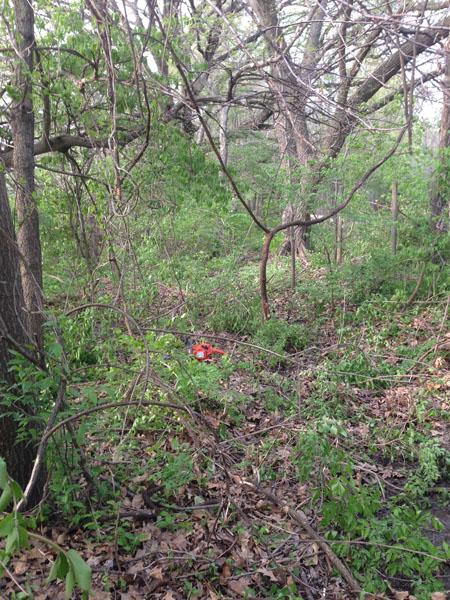 Before shot of what we’re working with. 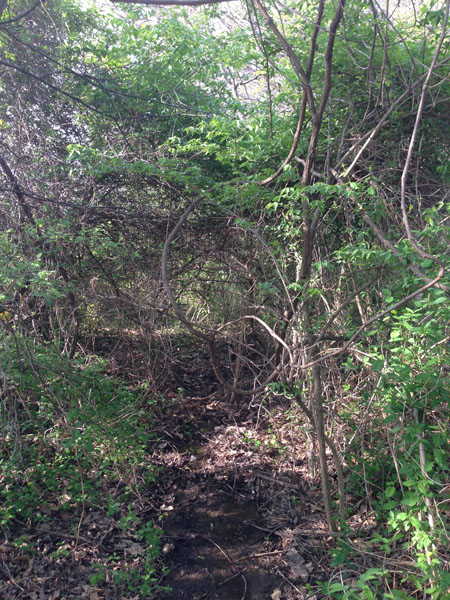 Another before view. That’s the stream running through the center. 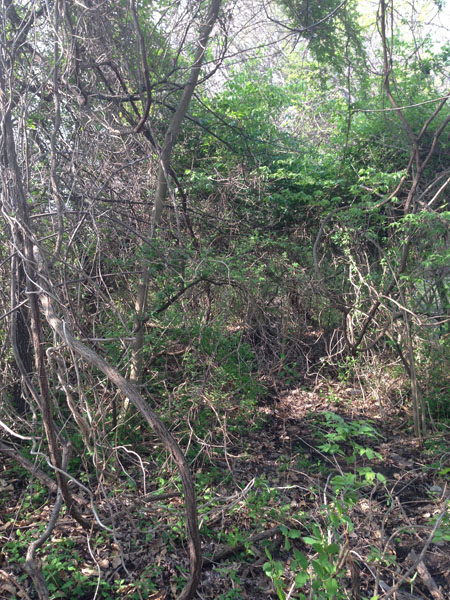 Lots of vines to hack our way through…there’s a path in there somewhere…  Hey! There’s one of our mama turkeys, setting on a clutch of eggs. She wasn’t very happy to see us cutting down the brush around her, but we piled it back up to give her some privacy, she’s one of the first critters in our habitat hedge row!  Finally, a bit more cleared away… Phase Two – 2015/2016
Labeling medicinal and native plants – Native and medicinal plants will receive a plaque that gives common and botanical names, historical and present uses and status if an endangered plant. The trail head will also have brochures with maps and points of interest/information about the medicinal and edible uses of many of the plants for self guided tours. Eventually I hope to also post signs explaining the natural habitats that we are creating for the fauna as well.
Continue planting, including native trees and shrubs – We will continue to build up the natural flora each year, working to see which habitats within this location best suit the plants we are planting.
Phase Three – late 2015 and beyond
Hosting plant walks for adults and kids – It is my ultimate goal to give guided tours to the adults in the community as well as the children of the community to teach them awareness about growing native species, not spraying their own lawns and how to create their own native gardens, incorporating native at risk plants into their landscapes to help preserve our native plants.
Maintenance and continual planting – We’ll host work days for folks of the community to come out and assist with weeding out the invasives that are sure to return in the first few years of growing this garden and to help divide and spread the plants as they begin to grow.
*On United Plant Saver’s “At Risk” List
**On United Plant Saver’s “To Watch” List
Sources for Native and Endangered Medicinal Herbs:
Companion Plants
Horizon Herbs
Thyme Garden
Mountain Gardens

This entry was posted
on Friday, April 17th, 2015 at 12:33 am and is filed under Uncategorized.
You can follow any responses to this entry through the RSS 2.0 feed.
You can leave a response, or trackback from your own site.

After years of putting off the paperwork required, this winter I took the time to fill out the required paperwork for our farm to become a United Plant Savers Botanical Sanctuary. This is an exciting step forward in a direction I’ve been working towards for years, teaching the public about endangered species, bringing awareness on the use of these plants as well as knowledge on practicing sustainable growing methods to ensure the future of these wonderful plants.
I’ve had a small woodland garden on our property for years but now we will be expanding this garden to cover the entire length of the western edge of our property as well, as this little garden is bursting with plants that are ready to spread their roots and seeds in a larger space.
Stay tuned, we’ll be having plenty of updates on our upcoming projects!
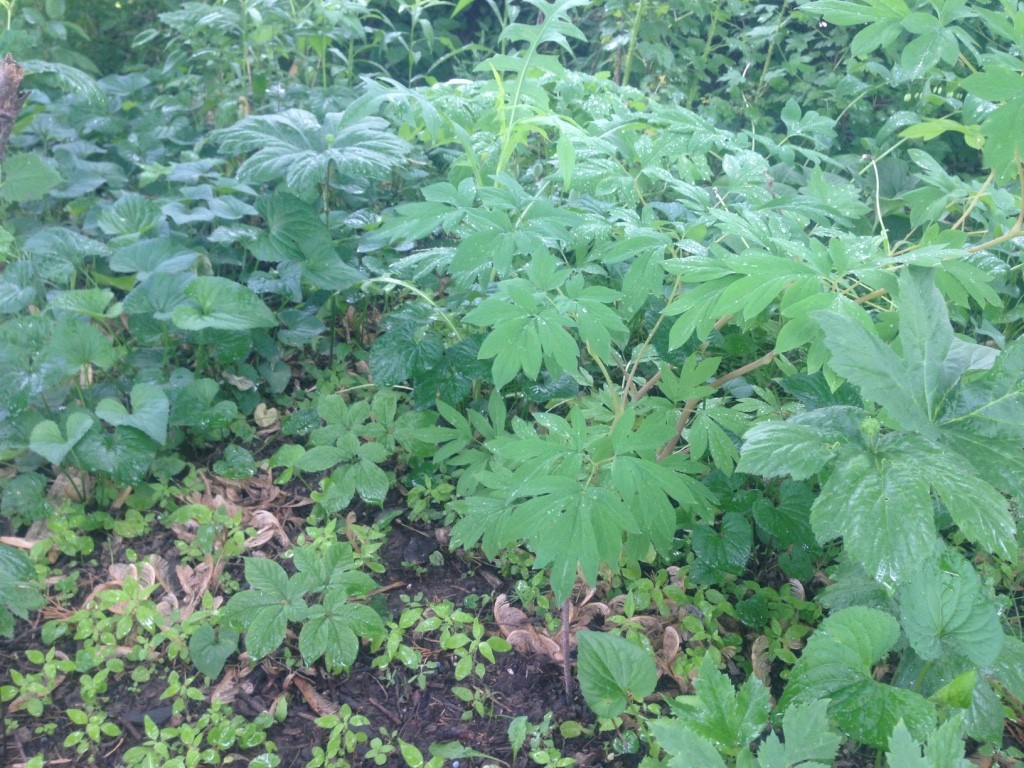

This entry was posted
on Friday, February 20th, 2015 at 12:43 pm and is filed under Uncategorized.
You can follow any responses to this entry through the RSS 2.0 feed.
You can leave a response, or trackback from your own site.

Join the cause! World Fire Cider Making Day is Sunday, February 2.
> Sign the petition to protect “Fire Cider” from trademark restrictionhttp://chn.ge/1be9xdb
> Browse hundreds of recipes on Pinterest http://bit.ly/MF39TZ
> Tweet and share your photos on Sunday #freefirecider
For more information about this cause, please go to my webpage on Herbal Roots zine.

This entry was posted
on Friday, January 31st, 2014 at 7:24 pm and is filed under Uncategorized.
You can follow any responses to this entry through the RSS 2.0 feed.
You can leave a response, or trackback from your own site.

In this part of my preparedness series, I will talk about different common and uncommon diseases, illnesses and other health inflictions that wouldn’t be easily treated during a long term crisis. This is not a replacement for medical advice, it is just my notes on how to cope with the situation using herbs if no medical help was available due to a long term crisis or other disaster scenario. It is intended for educational purposes only. All cases of tuberculosis should be assessed and treated by a medical provider when necessary.
Also known as “TB” or the consumption, tuberculosis (Mycobacterium tuberculosis) is a bacterial infection that usually attacks the lungs but it can also travel through the bloodstream and the lymph nodes to other parts of the body. It is a contagious air-borne disease that is easily spread by casual contact. It is easily spread through coughing, sneezing, spitting, discharging mucus and kissing.
In the 19th century, 25% of the deaths in Europe were caused by tuberculosis. To this day, 3 million people die from tuberculosis every year, mainly in developing countries.
The bacteria usually remain dormant in the body. 90% of those infected with the bacteria produce tuberculosis antibodies but will show no signs of infection and cannot spread the disease.
The disease is often difficult to treat and strains are now showing up that are resistant to antibiotics. About 1% of new cases in New York City are caused by bacteria that are resistant to 1 antibiotic and 7% of the recurrent cases are resistant to 2 or more antibiotics. Those who are infected with the resistant bacteria has only a 50% chance of survival.
Complications can cause lungs to collapse, fluid to form between the lungs and the lung membrane, complete obstruction of the airway passages and more. It can also turn into military disease and tubercular meningitis.
During normal times, antibiotics should be taken. Pyrazinamide and streptomycin are the main antibiotics used. If no antibiotics are available, be prepared to use a heavy arsenal of herbal antibiotics to try to combat the disease.
Any phlegm coughed up should be buried or burned to destroy the bacteria and keep it from spreading. Do the same with stools and urine. Wash all clothing, bedding and linens in hot water with bleach.
Those attending the patient should wear a N95 respirator mask.
Incubation Period: 3 – 6 weeks, though it can lie dormant for years
Symptoms of Active Tuberculosis: 3 weeks
75% of those infected with active tuberculosis will show signs of pulmonary tuberculosis:
Cough lasting longer than 3 weeks
Chest pain
Cough produces bloody mucus
Night sweats
The other 25% of those infected with active tuberculosis will show signs of extrapulmonary tuberculosis which is not contagious but often will co-exist with pulmonary tuberculosis. Those with extrapulmonary tuberculosis are often already immunosuppressed people and children. Locations of extrapulmonary tuberculosis include:
Central nervous system in meningitis
The pleura (the membrane that wraps around the lungs)
The lymphatic system in scrofula of the neck
Bones and joints in Pott’s disease of the spine
Tuberculosis has been successfully treated in other countries using herbal medicines. Treatment must be continuous and taken for at least 6 months and best taken for at least 1 year. This is because tuberculosis bacteria die slowly.
Step 1: Boost the immune system
Begin taking herbs to boost the immune system. Those who come in contact with the patient should also take these herbs to boost their own immune system.
Echinacea (E. purpurea, E. angustifolia, E. pallid
A strong dose is recommended: 1 drop of tincture for every pound of body weight taken 4 times a day for 10 days.
Elderberry (Sambucus nigra)
Elderberry is an immunomodulator. Take 1 dropperful every 2 hours for 7 – 10 days.
Take large doses of vitamin C. Rose hips, Elderberries, Pine needles, tomatoes, citrus fruits all have large doses of vitamin C.
It is important to get fresh air daily and the patient should practice deep breathing.
Daily exposure to sunlight is important too, exposing the eyes without glasses or contacts for at least 15 minutes daily.
Keep the patient warm and do not allow them to become chilled.
Step 3: Eat nourishing foods
Avoid eating sugary foods, preservatives, alcohol, caffeine, nicotine and any medications that may contain immune suppressing substances.
Add foods and herbs to the diet that include both vitamins and minerals such as vitamins A, B6, C, E, Beta Carotene, Selenium, Amino Acids, Lysine and Zinc.
The following vegetables and herbs should be eaten in large quantities:
Beets, carrots, garlic and medicinal mushrooms such as Reishii (Ganoderma lucidum) and Shitake (Lentinus edodes) which can both be found in the wild.
Seaweeds, dark leafy greens, miso soup, dandelion greens, Nettles (as food and in infusions), sweet potatoes, broccoli, prunes and lentils.
Step 4: Antispasmodic Herbs
These herbs will be useful for soothing the cough and providing some relief. They are also healing for the lungs.
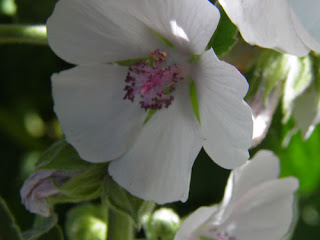
Marshmallow root (Althea officinalis)
Marshmallow should be incorporated into the regimen for treating tuberculosis. As a mucilaginous herb, Marshmallow will help to absorb toxins and carry them out through the stools. Cold infusions of marshmallow root are very soothing to the lungs and airways. Hollyhock root (Alcea spp.) and Okra pods (Abelmoschus esculentus) are both related and can be used interchangeably if Marshmallow is not available.
Lobelia (Lobelia inflata)
Dosage is 5 drops tincture.

Wild Cherry (Prunus serotina)
Wild Cherry Elixir or cough syrup is soothing to the lungs and will help with coughing spasms. Take 1 teaspoonful as needed.

Mullein (Verbascum thapsus)
Daily infusions of Mullein leaf can soothe irritated lungs and aid in healing. Strain infusion as some people find the hairs irritating to the throat.
Elecampane (Inula helenium)
Honeyed Elecampane roots can be sucked on to relieve coughing (see recipes). Take 10 drops tincture as needed.

Comfrey (Symphytum officinale)
Comfrey is a great healer. Drink infusions of Comfrey leaf daily and rub Comfrey root oil or salve onto the chest to help with spasmodic coughing and to help heal lungs.
Horehound (Marrubium vulgare)
Horehound succus can be taken to relieve coughs. Horehound is an antispasmodic and specific for coughs. Take 1 teaspoonful as needed.

Thyme (Thymus vulgaris)
Thyme soothes irritated throat, has antibacterial properties and can help calm spasmodic coughs. Drink 1 cup of tea 3 times a day.
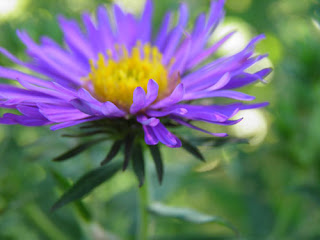
New England Aster (Aster novae-angliae)
New England Aster is used for treating asthmatic conditions and is sedating. Take 1 dropperful as needed. May be combined with Elecampane as they work well together for conditions of the lungs.
Onion (Allium cepa)
Onions have been used to cure patients of tuberculosis. Eat onions several times a day. For coughs, make a succus of chopped up onions and honey and take 1 teaspoonful as needed.
Step 5: Other Herbal Treatment
The following are various herbal treatments that are recommended to be used for treating tuberculosis. Use what you have available in your region. They will need to be taken daily for the next 6 months – year.

Forsythia (Forsythia suspensa)
James Green recommends combining twigs of Forsythia with Honeysuckle flowers (Lonicera japonica) in a 1:2 ratio in a tea or hot lemonade, up to 3 cups per day.

Honeysuckle (Lonicera japonica)
China has used Honeysuckle for centuries to treat all sorts of respiratory problems, including tuberculosis. Use a tincture of the flowers, 2 droppersful 3 times a day, or a handful of fresh flowers in a cup of boiling water, drank 3 times a day. If not flowering, use twigs and dried leaves to make a bitter tea which can be flavored with other herbs and sweetened with honey.
Licorice (Glycyrrhiza glabra)
Another herb used by China for treating tuberculosis, the roots are sweet and often accepted by children for the sweet, familiar taste. Drink a cup of tea 2 times per day. Avoid licorice if patient has high blood pressure.
Garlic (Allium sativum)
A powerful antibiotic, garlic should be eaten with every meal. Cloves can be eaten raw, cooked or pickled. Eat several cloves each day. This is another herb used by the Chinese to treat tuberculosis and studies have shown that taking garlic while taking the antibiotics for tuberculosis actually enhance the action of them, making them more effective.

Ginger (Zingiber officinale)
1 dropperful 3 times daily. If available, fresh ginger can be boiled for 10 minutes then allowed to steep for 1 hour. Strain the liquid and add honey to sweeten.
Eucalyptus (Eucalyptus globulus)
This herb has also been found effective for treating tuberculosis. If you grow your own tree (in a container part for more temperate areas), you can make a tea form the fresh or dried leaves to drink 3 times a day. Otherwise, you can use 1 – 2 drops of essential oil in a cup of water or herb tea. Do NOT use more than 2 drops as it is very potent.
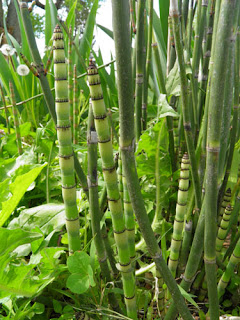
Horsetail (Equisetum arvense)
The silica content in the bones is reduced by tuberculosis. Silica is needed to develop resistance to disease so it is important to restore the silica levels in the bones. Take 1 dropperful of tincture 3 times daily while being treated for tuberculosis.
Berberine Rich Herbs
Berberine inhibits bacterial diarrhea caused by Mycobacterium tuberculosis. Herbs such as Goldenseal (Hydrastis canadensis), Oregon Grape Root (Berberis aquifolium), Goldenthread (Coptis chinensis) and Barberry (Berberis vulgaris) should be taken daily. Dosage should be 1 – 2 droppersful 2 times daily.
Poke root (Phytolacca americana, P. decandra)
This herb is a low dose botanical and needs to be respected but it is a powerful herbal treatment for lymph and glandular problems as well as an extreme immune booster. It is also an antibacterial and magnifies the effects of Echinacea which should also be taken when treating tuberculosis. Do NOT increase this dosage as serious side effects can take place including dizziness, seeing floaters, spaciness, vomiting, prostration, convulsions and death. When taken appropriately it is safe and highly effective. Take 1 – 3 drops of tincture per DAY up to 3 months. If symptoms of overdosing appear at any time, back off from the dose.

Cleavers (Galium aparine)
Cleavers is another herb that cleanses the lymph. Take 1 dropperful of tincture 2 times a day or 2 cups of tea each day.
Sources
Back To Eden by Jethro Kloss pgs. 344, 371, 544 – 547
The Green Pharmacy by James A. Duke, Ph.D. pgs. 431 – 434

This entry was posted
on Tuesday, April 17th, 2012 at 2:47 pm and is filed under Uncategorized.
You can follow any responses to this entry through the RSS 2.0 feed.
You can leave a response, or trackback from your own site.

In this part of my preparedness series, I will talk about different common and uncommon diseases, illnesses and other health inflictions that wouldn’t be easily treated during a long term crisis. This is not a replacement for medical advice, it is just my notes on how to cope with the situation using herbs if no medical help was available due to a long term crisis or other disaster scenario. It is intended for educational purposes only. All cases of polio should be assessed and treated by a medical provider.
What is it?
It is a virus which only infects humans. It is more common during summer months in temperate climates. The virus lives in the intestinal tract and the mucus of the nose and throat.
It should be noted that there is some dispute that polio is caused by a virus and the possibility of polio actually being symptoms of DDT poisoning. For more information, see sources at the end of this chapter.
Why should it be feared?
It is highly contagious. Anyone residing in close proximity of the infected person will most likely contract the virus. It is generally spread through handling the infected person’s stools. There has been some research showing flies may also contribute to the spread of the virus.
Up to 95% of the people who are infected will have no symptoms but will still spread the virus to others.About 2 – 5% of children and 15 – 30% of adults infected with the poliovirus will die from the infection.
Polio can cause paralysis, myocarditis (inflammation of the heart muscle), high blood pressure, fluid in the lungs, pneumonia and urinary tract infections.
What should be done?
During normal times, there is no treatment for the polio virus. Supportive care is used to control fever or pain. Fluids are offered to keep the patient from becoming dehydrated and the patient should rest until the fever is gone. For every 3 days of fever, 2 extra days should be spent resting.
For severe cases, medications are given to reduce pain and improve strength. Antibiotics are given for treating secondary bacterial infections, if they should arise. Antibiotics will not do any good for the actual poliovirus. Breathing assistance with a ventilator may be necessary as well.
What are the stages and symptoms?
Incubation Period: 4 – 35 days
While the incubation period runs between 4 and 35 days, symptoms usually start 7 – 14 days after becoming infected with the poliovirus.
Those infected with the virus are contagious 7 – 10 days before and after symptoms are seen and can spread the virus for weeks in their stools.
Symptoms
Up to 95% of the people infected with the virus will have no symptoms. There are 3 types of polio:
I. Minor polio, referred to as abortive poliomyelitis. Minor symptoms last 2 – 3 days with complete recovery and no paralysis or other serious symptoms will occur. 4 – 8% of the people who are infected will develop minor symptoms which include:
Fever
Sore throat
Abdominal pain
Constipation
Nausea
Vomiting
Flu-like symptoms
2. Aseptic meningitis
Early symptoms can be similar to minor polio symptoms. Then aseptic meningitis symptoms can develop but will improve within 2 – 10 days with complete recovery. It is estimated 5 – 10% of infected people will develop this type of symptoms. Aseptic meningitis symptoms include:
Stiffness of the back or legs or back/leg pain
Stiffness in neck or neck pain
Increased or abnormal sensations
Fatigue
Muscle spasms
3. Paralytic poliomyelitis
Less than 1% of those infected with poliovirus will result in paralysis. Those falling in this category will begin with other minor illness symptoms plus:
Fever
Muscle aches
Loss of reflexes
After several days, the symptoms will improve. 5 – 10 days later, the fever returns and paralysis begins and progresses for 2 – 3 days. Usually, once the temperature returns to normal, the paralysis goes away. The risk of paralysis increases with age. Children 5 and under often have paralysis in 1 leg. Adults often have paralysis in both arms and legs. Most people with paralytic symptoms recover completely and muscle function returns to some degree. If paralysis hasn’t resolved after 6 months, it is usually permanent. Other paralytic poliomyelitis symptoms include:
Painful muscle cramps
Muscle Twitching
Bladder muscles may be disabled, causing uncontrolled urination
Breathing may be affected
Headache
There are several types of paralytic poliomyelitis:
Spinal polio
Most common, affects the nerve cells in the spinal cord and may cause paralysis of the muscles that control breathing and the arms and legs. If neurons are completely destroyed, there will be no recovery from paralysis.
Bulbar polio
Sever type, affects the cranial nerves which control the ability to see, hear, smell, taste and swallow. May also affect the movement of muscles in the face, heart, intestines and lungs. Affects ability to breathe, speak and swallow and can be fatal without respiratory support.
Bulbospinal polio
A combination of bulbar and spinal paralytic polio and can lead to the paralysis of arms and legs and also affect breathing, swallowing and heart function.
Post-Polio Syndrome
Some people who have recovered from polio will contract Post-polio syndrome 10 – 40 years after the initial illness. Signs and symptoms include:
General fatigue and exhaustion after minimal activity
Breathing or swallowing problems
Muscle and joint pain
Sleep apnea and other sleep related breathing disorders
Decreased tolerance to cold temperatures
Muscle weakness in arms and legs that may or may not have been originally affected
What are my options?
Prevention is the best medicine. Cleanliness is best to avoid contracting the disease. Avoid sugar and increase calcium in the diet. Quarantine anyone suspected to be infected.
Step 1: Kenny packs.
Named after a nurse from Australia who practiced this treatment with her patients. She applied hot water packs to the patients on parts or all of their bodies. Have the patient take hot baths or apply hot water bottles to the body and wrap in wool blankets.
Step 2: Boost the immune system
Vitamin C supplements or herbs high in vitamin C such as pine needle tea (Pinus spp.) and rose hips (Rosa spp.) tea and/or tincture, elderberries, citrus, strawberries, basil, cilantro, thyme, parsley, bell peppers, dark leafy greens, mulberries, passionfruit, tomatoes should be given.
Echinacea (Echinacea spp.) given hourly (tincture form, 1 dropperful) or alternated hourly with Elderberry (Sambucus nigra) tincture, 1 dropperful, through duration of illness.
Avoid sugars, alcohol (tinctures are ok), and processed foods. Feed patient wholesome food, dark, leafy vegetables, nourishing bone broths, etc.
Step 3: Herbal Treatments
Antispasmodic Herbs
If patient is having muscle spasms, abdominal cramping or muscle cramps, use any of these herbs you have available:
Tincture or tea, taken internally, 1 dropperful or 1 cup of tea as needed unless otherwise noted.
Cramp Bark (Viburnum opulus)
Tincture can be applied directly to the area and rubbed on like a liniment or taken internally.
Catnip (Nepeta cataria)
Peppermint (Mentha piperita)
Tincture or tea, taken internally. Essential oil can be applied to cramped area, it should be diluted, 1 – 2 drops in 1 teaspoon carrier oil (whatever you have available).
Thyme (Thymus vulgaris)
Wild Cherry (Prunus serotina)
Tincture, tea or syrup, taken internally, 1 dropperful, 1 cup of tea, 1 teaspoons syrup as needed.
Cannabis (Cannabis indica, C. sativa)
Infused animal fat or coconut oil, applied locally to muscle spasms or used as massage oil.
Motherwort (Leonurus cardiaca)
Useful for heart conditions, heart palpitations and other problems of the heart. Use if heart problems are suspected. Tincture, 1 dropperful as needed.
Nervines
These herbs will help soothe nerves that are being attacked by the virus while helping to calm the patient.
St. John’s Wort (Hypericum perforatum)
Tincture taken internally, 10 – 15 drops 3 times a day. Infused oil used during massage.
Milky Oats / Oatstraw (Avena sativa)
Infusions of Oats (both tops and straw) are very soothing to the nervous system. A bag of oatmeal in the hot baths will also help in soothing the body.
Lemon Balm (Melissa officinalis)
Tincture, 1 dropperful every 2-4 hours or tea, 1 cup 4 times a day.
Motherwort (Leonurus cardiaca)
Useful for heart conditions, heart palpitations and other problems of the heart. Use if heart problems are suspected. Tincture, 1 dropperful as needed.
Sedative Herbs
Herbal sedatives are helpful for treating patients’ anxiety towards paralysis and muscle weakness. Keeping the patient calm is important.
Tincture or tea, taken internally, 1 dropperful or 1 cup of tea 3 times per day unless otherwise noted. Can be taken every 15 – 20 minutes for first hour.
Passionflower (Passiflora incarnata)
Lemon Balm (Melissa officinalis)
Motherwort (Leonurus cardiaca)
Useful for heart conditions, heart palpitations and other problems of the heart. Use if heart problems are suspected.
Antiviral Herbs
These herbs are antivirals and may help reduce the virus in the body. These can be combined or used singly. Use what you have available.
Tincture or tea, taken internally, 1 dropperful or 1 cup of tea 3 times per day unless otherwise noted.
Sage (Salvia officinalis)
Sage is often used in the treatment of cardiovascular diseases. Use if heart problems are suspected.
Catnip (Nepeta cataria)
Calendula (Calendula officinalis)
Tincture, taken internally, 1 dropperful or 1 cup of tea 3 times per day.
Thyme (Thymus vulgaris)
Japanese Knotweed (Polygonum cuspidatum)
Studies in China show promise for Japanese Knotweed inhibiting poliovirus. Tincture of roots/rhizomes, 1 – 2 droppersful 3 times a day.
Step 4: Massage and Physical Therapy
This treatment should be reserved for the recovery stage, after the fever lowers. Passive and strengthening exercises, sitting balance and standing balance training all should be incorporated.
Light massage can be helpful during and after the onset of symptoms. Make a massage oil out of any available oil infused with equal parts of Skullcap (Sculletaria laterflora), Goldenrod (Solidago spp.) and St. John’s Wort (Hypericum perforatum) oil.
Sources
Vaccinations: A Thoughtful Parent’s Guide. How to Make Safe, Sensible Decisions about the Risks, Benefits and Alternatives by Aviva Jill Romm pgs.
Healing Lyme Disease Naturally by Wolf D. Storl, A Necessary Comment Regarding Polio pgs. 80 – 82
http://www.physiotherapy-treatment.com/polio-treatment.html
http://naturalencyclopedia.com/Polio
http://www.tolaymat.com/Diet-English/Illnesses/Polio-E.html
http://polio.emedtv.com/polio/treatment-for-polio.html
http://www.itmonline.org/arts/coxsackie.htm

This entry was posted
on Monday, April 2nd, 2012 at 6:21 pm and is filed under Uncategorized.
You can follow any responses to this entry through the RSS 2.0 feed.
You can leave a response, or trackback from your own site.

In this part of my preparedness series, I will talk about different common and uncommon diseases, illnesses and other health inflictions that wouldn’t be easily treated during a long term crisis. This is not a replacement for medical advice, it is just my notes on how to cope with the situation using herbs if no medical help was available due to a long term crisis or other disaster scenario. It is intended for educational purposes only. All cases of anthrax should be assessed and treated by a medical provider.
Anthrax is an infectious disease caused by spore-forming bacteria known as endospores. It most commonly appears in domestic and wild herbivores such as cattle, sheep and goats but can also occur in humans when they are exposed to infected animals or tissue from the infected animals. While carnivores (including humans) can contract the disease from eating herbivores, there is little chance of it being spread from human to human by contact.
Anthrax has also been listed as a potential biological weapon and has been used as such in the past.
Spores live in the soil and can live for decades before an animal comes into contact with the spores (usually by grazing) and is infected.
When humans come in contact with the spores through inhalation, the disease can cause severe and fatal respiratory collapse. Historical mortality was 92% and in modern times when treated early, mortality was 45%.
Those who contract anthrax through eating tainted meat face a 25% – 60% chance of dying from the disease, depending on how quickly it is treated.
The least feared form comes from those who contract anthrax through cuts in their skin. It is rarely fatal if treated and those who go untreated face a 20% chance of progressing to toxemia and death.
During normal times, testing should be done to determine which type of anthrax has been contracted and antibiotics should be given both intravenously and orally. Antibiotics used are erythromycin, vancomycin, penicillin, cyprofloxacin or doxycycline. For inhalation anthrax, a new drug, raxibacumab, also known as ABthrax was created for emergency treatment of inhaled anthrax. If death occurs from anthrax, the body should be isolated to prevent the spread of anthrax germs. Burial does NOT kill anthrax spores.
There are three ways of contracting anthrax:
Inhalation / Pulmonary – Caused by inhaling spores. Has highest death rate. This mode of infection is the mode used as a bioweapon.
Ingestion / Gastrointestinal – Contracted by eating anthrax-infected meat. This is the rarest form of anthrax contraction at time of publication.
Cutaneous – Infection is contracted by the bacteria entering the body through a cut in the skin. This method is the most highly contracted form (95% of all anthrax cases are cutaneous), least lethal and easiest to treat.
Those who died due to known or suspected anthrax contraction should be cremated and all items, bedding, linens, etc. coming in contact should also be burned to destroy the endospores. Buried spores will continue to live and may contaminate the surrounding ground over which they are buried.
Those handling bodies with anthrax/suspected anthrax exposure should use respiratory masks capable of filtering particles 0.5–5.0 μm as this is the bacilli size range. A disposable gown and gloves should be worn as well.
Clothing, linens, etc. can be decontaminated by boiling in water for a minimum of 30 minutes. Chlorine beach will NOT kill spores.
Incubation Period: 24 hours – 2 months
Incubation depends on the type of contracted anthrax.
Inhalation: less than 7 days – 2 months
Cutaneous: up to 24 hours
Initial symptoms: 1-5 days
Inhalation: Symptoms begin with cold or flu-like symptoms such as sore throat, mild fever, nonproductive cough, fatigue, chest discomfort, muscle aches, sweating and malaise.
Ingestion: Begins with nausea, loss of appetite, vomiting and fever which progresses to severe abdominal pain, vomiting blood and diarrhea that is usually bloody.
Cutaneous: Starts out as a raised, itchy bump that may resemble an insect bite. Localized itching may occur as well. Within 1 – 2 days the bump changes to a blister.
Progressive symptoms: 4 – 8 days
Inhalation: After a 1 – 5 days of initial symptoms, there may follow 1 – 3 days of improvement after which an abrupt onset of high fever and severe respiratory distress occurs.
Ingestion: Spreads throughout bloodstream, creating more toxins and causing abdominal pain, severe diarrhea and vomiting blood. Lesions may appear in the mouth and throat (and intestines which will not be seen). 2 – 4 days after symptoms begin, abdominal pain decreases while accumulation of fluid develops in the abdomen.
Cutaneous: 7 – 10 days after developing the bump, changes into a painless ulcer that is 1/3 – 1 inch in diameter with a necrotic center that is black. Lymph glands in the surrounding area may swell.
Death generally peaks at 8 days after exposure.
Inhalation: Shock, followed by death typically caused by respiratory collapse within 24 – 36 hours after high fever occurs.
Ingestion: Shock and death occur 2 – 5 days from onset of symptoms.
Cutaneous: As long as treated, rarely occurs.
Even if you cannot get antibiotics, treatment is possible IF it is caught early enough. The most common form (cutaneous) has an 80% chance of resolving on its own.
Inhalation: Use a neti pot to rinse your nasal passages if you suspect exposure. Follow directions supplied with the neti pot. After you have rinsed your nose, spit out any liquid that runs into your mouth and blow your nose.
Cutaneous: Flush the wound with a saline solution
Step 2: Boost the immune system
Begin taking herbs to boost your immune system.
Echinacea (E. purpurea, E. angustifolia, E. pallida)
A strong dose is recommended: 1 drop of tincture for every pound of body weight taken every hour for at least 10 days.
Elderberry (Sambucus nigra)
Elderberry is an immunomodulator. Take 1 dropperful every 2 hours for 7 – 10 days.
Take large doses of vitamin C. Rose hips, Elderberries, Pine needles, tomatoes, citrus fruits all have large doses of vitamin C.
Step 3: Eat nourishing foods
Avoid eating sugary foods, preservatives, alcohol, caffeine, nicotine and any medications that may contain immune suppressing substances.
Add foods and herbs to your diet that include both vitamins and minerals such as vitamins A, B6, C, E, Beta Carotene, Selenium, Amino Acids, Lysine and Zinc.
The following vegetables and herbs should be eaten in large quantities:
Beets, carrots, garlic and medicinal mushrooms such as Reishii (Ganoderma lucidum) and Shitake (Lentinus edodes) which can both be found in the wild.
Seaweeds, dark leafy greens, miso soup, dandelion greens, Nettles (as food and in infusions), sweet potatoes, broccoli, prunes and lentils.
The following are various herbal treatments that have been suggested to be used for treating anthrax. Use what you have available in your region. Combine as many herbs as possible. Herbs that go especially well together will be mentioned in their descriptions.
Poke root (Phytolacca americana, P. decandra)
This herb is a low dose botanical and needs to be respected but it is a powerful herbal treatment for lymph and glandular problems as well as an extreme immune booster. It is also an antibacterial and magnifies the effects of Echinacea which should also be taken during an anthrax scare. Do NOT increase this dosage as serious side effects can take place including dizziness, seeing floaters, spaciness, vomiting, prostration, convulsions and death. When taken appropriately it is safe and highly effective. As a preventative, 1 drop of tincture per DAY up to 3 months. If contact is suspected, dosage may be increased up to 1 drop 6 times a day depending on body weight. For children, stick to 1 drop a day and for teenagers and adults up to 110 lbs, use 1 drop 3 – 4 times a day, backing off if any symptoms of overdose appear. For adults and teens over 110 lbs, use 1 drop 4 – 6 times a day, backing off if any symptoms of overdose appear.
Yarrow (Achillea millefolium)
Yarrow kills both gram positive and gram negative bacteria. Tincture can be added to the neti pot for rinsing the nose (add a dropperful to the pot before flushing). Take 1 dropperful 4 times a day for 20 days.
Cayenne (Capsicum annuum)
Cayenne is antibacterial and useful for many things. It can be sprinkled directly into a cutaneous anthrax wound site or made into a tincture to be added to water and drank. Adding it to your food can be helpful too. As a tincture, take 20 – 30 drops in a cup of water 2 times a day.
A powerful antibiotic, garlic should be eaten with every meal. Cloves can be eaten raw, cooked or pickled.
Licorice root (Glycyrrhiza glabra)
Considered to be one of the most important herbs in the world by many herbalists, this herb can help flavor less tasty herbs while being useful to kill bacteria, boost the immune system and nourish the lungs among other things. It is thought to harmonize the action of all other herbs. 1 cup of tea 3 times daily or 1 dropperful 3 times daily.
Another powerful antibacterial, tincture dose is 1 dropperful 2 times a day for 10 days.
Ginseng root (Panax quinquefolius, P. ginseng)
Boosts the immune system, and nourishes with the production of responses necessary to help fight off anthrax such as killer t-cells, interferon, antibodies and phagocytes. Can be taken as a tincture, tea or extract. Safe to take in large amounts but if you start feeling jittery, shaky and unpleasant, back off on your dosage.
Astragalus (Astragalus membranaceous)
Astragalus is safe and a long term immune booster and is restorative. It is best taken long term. Either tincture and take 1 dropperful 3 times daily for 6 months or add roots to daily food such as soup.
Wild Indigo (Baptisia tinctoria)
Wild Indigo is a natural antibiotic, capable of preventing microbes and bacteria from multiplying in the body. It also has an immune enhancing effect. Take 1 dropperful 3 times a day.
Eleuthero (Eleutherococcus senticosus)
Also referred to as Siberian Ginseng, Eleuthero is an adaptogen and will help the body to recover. 1 dropperful or 1 cup of tea taken daily for 1 month. Some people may have reactions to Eleuthero such as jitters, shaking, spaciness and headaches. Discontinue use if these symptoms appear.
Many kitchen herbs are antibacterial and useful for fighting off infection. A strong tea can be drank several times a day and can include kitchen herbs such as Thyme (Thymus vulgaris), Rosemary (Rosmarinus officinalis), Basil (Ocimum basilicum), Oregano (Origanum vulgare), and Sage (Salvia officinalis).
Sources

This entry was posted
on Monday, March 26th, 2012 at 11:19 am and is filed under Uncategorized.
You can follow any responses to this entry through the RSS 2.0 feed.
You can leave a response, or trackback from your own site.

In this part of my preparedness series, I will talk about different common and uncommon diseases, illnesses and other health inflictions that wouldn’t be easily treated during a long term crisis. This is not a replacement for medical advice, it is just my notes on how to cope with the situation using herbs if no medical help was available due to a long term crisis or other disaster scenario. It is intended for educational purposes only. All cases of MRSA should be assessed and treated by a medical provider when necessary.
What is it?
Methicillin resistant Staphylococcus aureus, known as MRSA, is a common type of staph bacterium that lives on the skin and in the nasal passages of 30% of the population. It is known as methicillin resistant because this particular strain of Staphylococcus has become resistant to the popular antibiotic methicillin which can no longer be used to kill off the staph bacteria.
Why should it be feared?
Although MRSA can be found on the body of 30% of the population, most will never have any problem related to it. However, it can cause a serious threat to those who have a weakened immune system, are ill or recovering from an illness, have been injured or have had surgery. If it enters the body through an open wound or through an instrument contaminated with MRSA or by cross-contamination from another person, it can be difficult to cure and can lead to death.
MRSA can enter the lungs and cause pneumonia. Urinary tract infections, bone infections and blood poisoning (bacteremia and sepsis) can also be caused by MRSA. Some staph infections can cause a “flesh eating bug” bacteria which are called necrotizing fasciitis. This bacteria does not eat flesh but causes the destruction of skin and muscle by releasing toxins.
MRSA is now resistant to methicillin, amoxicillin, nafcillin, penicillin, cephalexin, and oxacillin and other beta-lactam antibiotics.
What should be done?
During normal times, patients are usually treated by using clindamycin, tetracycline or vancomycin. Vancomycin is currently the first choice of treatment for MRSA and linezolid for treating MRSA pneumonia. MRSA is now showing signs of becoming resistant to vancomycin. Depending on the severity, IV antibiotics may be required.
If taking an antibiotic to treat MRSA or any other bacterial infection, follow the doctor’s instructions and take the full course to diminish the chance of creating a superbug.
Do not use antibacterial soaps and sanitizers which also create stronger, more resistant bacteria. Regular soap and water are sufficient to kill germs.
Alternatively, herbal medications are also showing great value for treating MRSA and may be used alone or in conjunction with conventional medications. Bacteria cannot become resistant to herbs the way they can synthetic drugs so they make a great choice to reach for when treating MRSA, especially when caught early.
Those caring for someone with MRSA should take precautions to not contract MRSA themselves. Wear gloves, disposable gowns and a face mask and burn all materials that come in contact with the bacteria to kill the bacteria.
What are the stages?
Incubation Period: weeks – years
MRSA can remain dormant on a carrier’s body for years without causing any problems.
Symptoms:
Symptoms usually show up quickly and include:
-Redness to affected area
-Swollen, painful
-Warm to touch
-Small red pimple-like bumps or a bump that looks like a spider bite
-Full of pus or draining
-Fever
-Red streaking moving out from the infected area
Secondary symptoms:
These symptoms could indicate the infection has spread to the blood, lungs or other parts of the body.
-Difficulty breathing
-Chills
-Chest pain
What are my options?
MRSA has been effectively treated with herbs in various parts of the world and can be easily treated using herbs in a crisis situation. The best line of defense is to catch it early and work with the immune system to fight it.
Step 1: Cleanse
Clean the area where the infection is visible. Use Echinacea tincture as a wound dressing (see information on Echinacea under Herbal Treatment).
Days 1 – 3: Place tincture on a sterile cloth or bandage over the affected area twice a day and attach with bandage or tape.
Days 4 – 10: Change bandage with Echinacea 1 – 2 times daily as necessary.
If the affected area is abscessed, it may be lanced and drained if there is someone qualified to lance it.
Step 2: Boost the immune system
Take large doses of vitamin C to help boost the immune system. If you do not have access to vitamin C, you can find it in many plants around you. Pine needles, rose hips, elderberries, citrus, strawberries, basil, cilantro, thyme, parsley, bell peppers, dark leafy greens, mulberries, passionfruit, tomatoes. Incorporate these foods into the patient’s daily diet, make teas from the herbs and use as many as possible non-stop for at least 2 weeks.
Diet should consist of bland foods such as rice, beans, steamed vegetables, bone broth, etc. Avoid sugar, alcohol, caffeine and other foods that suppress the immune system.
Step 3: Herbal Treatment
The following are various herbal treatments that have been suggested to be used for treating MRSA. Use what you have available in your region.
Herbs listed to be used as a wash can also be powdered and applied directly to the infected area if the area would better be suited to remain dry.
Honey (raw, from local sources)
Apply directly to the infected area, cover with a sterile bandage and change daily.
Echinacea (Echinacea purpurea, E. angustifolia, E. pallida)
Use a tincture of a combination of E. angustifolia and E. pallida roots mixed with E. purpurea roots, leaves and seeds for most effective treatment in 50% alcohol (though any available Echinacea can be used).
Days 1 – 3: patient should take 1 – 2 droppersful every 15 – 30 minutes for the first 3 hours. After the 3rd hour, decrease dose to 1 dropperful every hour while awake for 3 days.
Days 4 – 10: Continue taking 2 droppersful 3 times a day. If there is no improvement to infection, continue taking 2 droppersful tincture every 2 waking hours.
Garlic (Allium sativum)
Patient should eat up to 3 bulbs (not cloves) of garlic daily. Continue for at least 7 days after all signs of infection are gone. Pickled garlic (see recipes) may be eaten. May cause nausea or vomiting if consumed in large dosages.
Ginger (Zingiber officinale)
Fresh ginger may be eaten daily (pickled and candied are good too). 1 oz. fresh root or 2 teaspoons dried root to 8 oz. water. Simmer for 10 minutes. Add honey to sweeten if desired and drink throughout the day. Tincture of fresh root only, 1 – 2 droppersful 4 times daily.
Pau d’Arco (Tabebuia impetiginosa, T. avellanedae, T. heptaphylla)
Acacia (Acacia angustissima, A. constricts, A. greggii)
All parts of the Acacia tree are useful. For MRSA, use decoction of roots and drink up to 6 cups per day.
A wash of the leaves, stems and pods can be used on the infected area (before applying Echinacea tincture).
Mesquite (Prosopis julifera, P. pubescens)
Can be used as a substitute for Acacia. For MRSA, use decoction of roots and drink up to 6 cups per day.
A wash of the leaves, stems and pods can be used on the infected area (before applying Echinacea tincture).
Juniper (Juniperus spp.)
Juniper is high in vitamin C. Studies have proven Juniper to be effective against antibiotic-resistant bacteria. Tincture of cones (berries) 5 drops to 1 dropperful 3 times daily. Tea made from 2 teaspoons ground needles or cones per 8 oz. water steeped for 20 minutes, drink throughout the day.
A wash made from a strong decoction of the cones, needles, roots or bark can be used to cleanse the infected area several times daily. Use 1 oz. herb to 1 quart of water, simmer for 30 minutes then steep for 8 hours for use.
Sources
Herbal Antibiotics: Natural Alternatives for Treating Drug-Resistant Bacteria by Stephen Harrod Buhner

This entry was posted
on Monday, March 19th, 2012 at 9:34 am and is filed under Uncategorized.
You can follow any responses to this entry through the RSS 2.0 feed.
You can leave a response, or trackback from your own site.
I saw this idea on a prepper website but I cannot remember which one so I can’t credit them. If I find them, I’ll link back to their site as they had some great tips on there. They used neosporin type salve to create their packets but since I use all herbal salves I and my friends make, I decided to cater these to using my own salve.
To make them you will need:
-drinking straws (clear are best so you can see inside)
-tea light
-needle nosed pliers
-scissors (forgot to photograph but you know what those are!)
-your choice of salves
Begin by poking your straw into your salve. Imagine how much is usually needed for a typical wound and fill it to that point.
Pinch the end of the straw with your finger to push the salve further into the straw and create an empty space. Using the pliers, grip that space, leaving a tiny bit of straw sticking out of the side.
Hold the straw over the tea light to melt the end. Slide your pliers to the end and pinch it shut.
Gently squeeze the salve towards the sealed edge to verify your seal.
Turn the straw around and pinch the other edge as close to the salve as you can without squeezing the salve out the other side. Use your scissors to cut off the edge and seal as you did the other side, being sure to squeeze and check for leaks.
All finished! The straws I used gave me 5 individual packs per straw. These are perfect for storing in the first aid kit and will also be great for building a mini first aid kit to put in the kids’ back packs for when they go hiking in the woods. To open, simply use a knife.
Optionally, you can use a sharpie marker to write what type of salve is in the tube. Since I used 3 different types, I wrote down their names on each. Be sure to wash the tubes in soapy water first to remove any salve residue so the marker writing will be permanent.

This entry was posted
on Wednesday, March 14th, 2012 at 4:56 am and is filed under herbal first aid, tutorial.
You can follow any responses to this entry through the RSS 2.0 feed.
You can leave a response, or trackback from your own site.

This is a project of mine, researching different common and uncommon diseases, illnesses and other health inflictions that couldn’t be easily treated during a long term crisis due to lack of medical assistance or medicine. This is not a replacement for medical advice, it is just my notes on how to cope with the situation using herbs if no medical help was available due to a long term crisis or other disaster scenario. It is intended for educational purposes only.
What is it?
Also referred to as the “flu,” influenza is a virus caused by influenza viruses A, B and C that infect the respiratory tract of many animals, birds and humans.
Types A and B are the most common and cause respiratory illnesses that are often epidemic and usually during the late winter though they are often seen year round in all climates.
Type A viruses are divided into types based on two surface proteins, hemagglutinin (H) and neuraminidase (N). At this time there are 16 known H subtypes and 9 known N subtypes. The pandemic of 2009 was the swine flu, represented as H1N1 while the earlier avian flu was referred to as H5N1 and affected mainly birds. Type A infects humans, other mammals and birds.
Type A viruses go through 2 kinds of changes. The first is a series of mutations over time which causes a gradual evolution of the virus which is known as antigenic drift. The second is an abrupt change in the hemagglutinin and/or the neuraminidase proteins known as the antigenic shift. In the second case, a new subtype of the virus will emerge rapidly, causing pandemics.
Type B viruses change only by gradual processes and do not cause pandemics. They infect humans and seals.
Type C usually causes a very mild respiratory illness or none at all. They infect humans and pigs.
Influenzavirus A has the capability to rapidly mutate and change, causing pandemics that can be deadly, attacking the lungs and turning the immune system on itself, effectively causing the body to attack itself.
The pandemic flus have been known to attack young, healthy adults instead of the usual victims of influenza who tend to be infants, elderly or immune compromised individuals. The 1918 Spanish flu (H1N1) lasted for 18 months and is blamed for killing 50 – 100 million, or roughly 3% of the world’s population of 1.86 billion. 500 million or 27% of the world’s population were infected with the Spanish flu which spread to the Arctic and Pacific Islands.
Tissue samples from frozen victims were used to recreate the virus for study which led to the discovery that the virus kills through a cytokine storm. A cytokine storm is a overreaction of the body’s immune system, the turning of the immune system against the body which explains the severe nature of the virus and the unusual set of victims. In this instance, a weak immune system is actually a good thing.
Transmission is primarily through large-particle respiratory droplet transmission such as coughing or sneezing.
Influenza can also cause a secondary infection such as pneumonia which can become life-threatening.
During normal times, many advise to be vaccinated though the vaccine is often only speculation as the strains of the virus are so quickly mutated. During a pandemic, it is doubtful enough vaccines could be made in time to prevent the virus from spreading. Isolation is the best prevention. Keep yourself and your family in the house, if mail delivery is still running, use protective measures (rubber gloves) and do not bring it in the house. Discard unnecessary mail and let all other mail sit in a spot for at least 4 days to ensure the virus is dead before bringing it in the house.
For those who show symptoms of the flu, antiviral drugs such as oseltamivir (Tamiflu) and zanamivir (Relenza) are taken. During a pandemic, these antivirals may not be available. Additionally, the antivirals amantadine and rimantadine may be given to prevent the virus from infecting cells but are only effective against viruses which possess the M2 protein. Viral strains are now showing resistance to these antivirals.
Make sure the patient stays in bed, warm, well hydrated and eats well. Discontinue the use of tobacco, alcohol, sugar and processed foods.
Quarantine anyone coming into your household for 5 days. If they show any symptoms during this time period, treat them for influenza.
Caregivers should use caution in handling of patient, their bodily fluids and all clothing and linens. Wear a N95 respirator mask, gloves and gown.
Incubation Period: 1 – 4 days
Patient is infectious from 1 day before symptoms appear though children may shed the virus several days before symptoms appear.
Main Symptoms: 3 – 7 days up to 2 weeks for more severe strain
Initial symptoms are abrupt:
-Fever
-Malaise
-Myalgia
-Headache
-Nonproductive cough
-Sore throat
-Runny nose
Children may present other symptoms as well such as:
-Otitis media (earache)
-Nausea
-Vomiting
Some patients may only have respiratory symptoms without a fever.
Patients are infectious until 5 – 10 days after the onset of symptoms.
Infections can cause secondary illnesses such as:
-Viral pneumonia
-Bacterial pneumonia
-Sinusitis
-Otitis media
Children may experience febrile seizures (about 6 – 20%)
The first step is preventing influenza from invading your home and family. Take all precautions to avoid coming in contact with those infected. In the event of a threat of a pandemic, it is wise to keep children home from school and adults to stay home from work if at all possible. Wear N95 respirator masks and latex gloves when forced to be in public.
During the winter, keep healthy by getting plenty of sleep and fresh air, eating healthy, minimally processed foods and supplementing with a good source of vitamin D3. From the Fall Equinox until the Spring Equinox, all family members should take a daily dose of vitamin D3:
0 – 2 should take 1,000 – 2,000 IU
2 – 12 should take 2,000 – 5,000 IU
12 to adult should take 5,000 – 10,000 IU
Our primary source of vitamin D3 is through sunlight. However, during the winter months, the angle of the sun does not give those in the northern hemisphere enough exposure to supply us with enough D3. This is why most people become sick in late winter.
Step 2: Boost or Modulate the immune system
Before getting sick, boost your immune system to fight off infections. Daily doses of these herbs can assist with this but should be stopped if it is known or suspected that the virus operates using a cytokine storm:
Take lots of garlic (3 – 4 raw cloves a day). Continue to take even if symptoms appear as garlic can reduce cytokine storm.
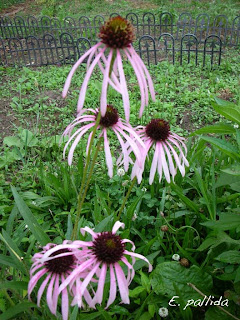
Echinacea (Echinacea purpurea, E. angustifolia, E. pallida)
Take 1 drop for every pound of body weight once a day.
Astragalus (Astragalus membranaceus)
Drink 1 cup of root decoction daily or take 1 – 2 droppersful daily.
If symptoms of the flu appear, discontinue taking the above herbs and switch to any of the following:

Elderberry (Sambucus nigra)
Syrup or elixir, 1 tablespoon 3 – 5 times per day
South African Geranium root (Pelargonium sidoides)
Tincture of root, 1 dropperful 3 times per day.
Holy Basil / Tulsi (Ocimum tenuiflorum)
Tincture, 1 dropperful 3 times per day.
Step 3: Support the Fever
Do NOT suppress the fever. Do not take acetaminophen or NSAID’s such as ibuprofen or aspirin. The fever’s purpose is to burn off the virus. Adults can go up to 108° F before human cells begin to die. For children, exceptions are for infants up to 1 month, 101.4° F may be critical which rises to 102° F at 2 months of age. As long as the patient is comfortable and the fever is below these critical points, allow the fever to burn.

Keep the patient well hydrated, offering herbal teas often. Herbs that will support the fever and help the body to burn and kill off the virus include:
Ginger (Zingiber officinale)
Cayenne (Capsicum annuum)
Osha root(Ligusticum porteri)
Peppermint (Mentha peperita)
Yarrow (Achillea millefolium)
Lemon Balm (Melissa officinalis)
Goldenrod (Solidago spp.)
Elderflower (Sambucus nigra)
Honeysuckle Flower (Lonicera japonica, L. sempervirens and other Lonicera spp.)
Of the above listed herbs, use what you have available and offer hot tea often. Keep an insulated pump pot (see supplies section) by the patient’s bed to have a supply of hot tea on hand at all times. Diaphoretics work by being dispensed hot.
Boneset (Eupatorium perfoliatum)
Antiviral, febrifuge; general and severe aches and pains “bone break” sensations caused by fever. Tincture 30 – 60 drops in warm water or tea every 2 hours. Infusion of herb (2 tablespoons per quart of water) frequently sipped (every 1 – 2 hours).
Step 3: Reduce Cytokine Storm Activity
The following herbs will inhibit influenza symptoms and inflammatory cytokines.
Take lots of garlic (3 – 4 raw cloves a day). Continue to take even if symptoms appear as garlic can reduce cytokine storm.
Baikal Skullcap Root (Scutellaria baicalensis)
Tincture 2 – 3 droppersful 3 times daily.
Cannabis (Cannabis sativa)
Infused oil, taken in capsule form. 1 00 capsule daily.
Ginger (Zingiber officinale)
If available fresh, 4 slices per 8 oz. water. Powdered root add 1/2 teaspoon to 8 oz water. Bring to boil, turn off heat, cover and let steep for up to 1 hour. Strain and drink 3 cups daily. Tincture 1 dropperful 3 times daily.
Red Sage Root (Salvia milthiorrhiza)
Tincture dosage: 50 drops 3 times daily.

St. John’s Wort (Hypericum perforatum)
Tincture of flowering tops, 3 – 4 droppersful 3 times daily.
Turmeric Root (Curcuma longa)
Powdered root add 1/2 teaspoon to 8 oz water. Bring to boil, turn off heat, cover and let steep for up to 1 hour. Strain and drink 3 cups daily. Tincture 1 dropperful 3 times daily.
Step 4: Soothe and Support the Cough
Teas are helpful for coughs as they are soothing and warming though tinctures are also beneficial and can be added to an herbal tea. The herbs below may be mixed together or used singly according to their availability.
Although not an herb, honey is an excellent treatment for soothing coughs. Adding powdered herbs such as turmeric, ginger and other mild tasting herbs can also help heal sore throats and irritation caused by coughing spasms. Honey can also be added to an herbal tea to increase the herbal tea’s power.
Use raw honey from a local source. “Honey” purchased from a store may not be live, rendering it useless for medicine. Honey may contain botulism spores and should be used with caution for babies under the age of 1.
Herbs for dry, spasmodic coughing:
Lobelia (Lobelia inflata)
Antispasmodic, mild expectorant. Tincture 10 drops to 1 dropperful every 3 hours as tolerated. If nausea develops, cut back dosage. Start with lowest dosage amount and increase if necessary.
Pleurisy Root (Asclepias tuberosa)
Expectorant, demulcent, relaxant, mild diaphoretic. Good for coughs with burning sensation, coughing up blood (indication of cytokine storm). Tincture 1 – 2 droppersful 3 – 4 times daily.
Licorice Root (Glycyrrhiza glabra)
Demulcent, antiviral. Decoction take 1 – 2 tablespoons every 3 hours. Tincture 1 – 2 droppersful every 3 hours.
Wild Cherry (Prunus serotina)
Antispasmodic, expectorant, antiviral. Syrup take 1 teaspoonful as needed. Tincture take 1 dropperful every 20 minutes until coughing eases then lower to every 2 hours or as needed.
Antispasmodic, expectorant, antiviral. Syrup take 1 teaspoonful as needed. Tincture take 1 dropperful every 20 minutes until coughing eases then lower to every 2 hours or as needed.
Balloon Flower root (Platycodon grandiflorus)
Anti-inflammatory, bronchial dilator, anti-tussive, expectorant. Take 1 – 3 droppersful 3 times daily.

Mullein (Verbascum thapsus)
If using leaves to make tea, strain through muslin and drink 3 cups daily or sip as needed.
Marshmallow (Althea officinalis)
Root or leaf can be used. If using root, make a cold decoction. Demulcent, ant-inflammatory. Drink 3 cups daily or take 1 dropperful 3 times daily.
Herbs for moist, hot coughs:
Hyssop (Hyssopus officinalis a.k.a. H. decumbens)
Especially helpful for later stages of influenza. Tincture, 1 dropperful or 1 cup tea 3 times daily.
Elecampane root (Inula helenium)
Expectorant, anti-tussive. Tea can be made from the dried root but it will be bitter. Sucking on honeyed roots can be very helpful (see recipes). Tincture can be taken, 1 dropperful every 2 – 4 hours.
Plantain (Plantago lanceolata, P. major)
Astringent, expectorant, antispasmodic, tonifying for mucous membranes. Hot tea works exceptionally well, especially when combined with Thyme. Drink 3 cups daily or as needed. If using tincture, take 1 dropperful 3 times daily or as needed.

Antiseptic, antibiotic, expectorant. Hot tea works exceptionally well, especially when combined with Plantain. Drink 3 cups daily or as needed. If using tincture, take 1 dropperful 3 times daily or as needed.

Goldenrod (Solidago spp.)
Drying, astringent, anti-inflammatory. Drink 3 cups daily or as needed. If using tincture, take 1 dropperful 3 times daily or as needed.
The Practice of Traditional Western Herbalism by Matthew Wood
Back To Eden by Jethro Kloss pgs. 355, 357, 498 – 499

This entry was posted
on Monday, March 12th, 2012 at 3:25 pm and is filed under Uncategorized.
You can follow any responses to this entry through the RSS 2.0 feed.
You can leave a response, or trackback from your own site.

This is a project of mine, researching different common and uncommon diseases, illnesses and other health inflictions that couldn’t be easily treated during a long term crisis due to lack of medical assistance or medicine. This is not a replacement for medical advice, it is just my notes on how to cope with the situation using herbs if no medical help was available due to a long term crisis or other disaster scenario. It is intended for educational purposes only. All cases of cholera should be assessed and treated by a medical provider.
Cholera is a bacterial infection of the small intestine caused by the bacterium Vibrio cholerae. It occurs primarily by drinking contaminated water or eating contaminated food. Contamination can come from an infected person, regardless is they are showing symptoms or not. Seafood is often the cause of cholera outbreaks in the developed world.
It causes diarrhea and vomiting which if left untreated can cause death, usually through dehydration.
The severity of the diarrhea and vomiting can quickly lead to dehydration which can lead to death. About 3 – 5 million people are affected per year. There are about 100,000 – 130,000 deaths per year related to cholera infection worldwide.
When treated, mortality rate is less than 1%. If left untreated, it can be as high as 60%. Some strains such as those seen in Haiti and India in the mid-2000’s caused death within 2 hours for the first sign of symptoms.
75% of those infected will not show symptoms while the bacteria present in their stools can live 7 – 14 days after infection, potentially infecting others. 80% of those who develop symptoms will only have mild or moderate symptoms. The remaining 20% will develop acute watery diarrhea and severe dehydration which can lead to death if untreated.
During normal times, unsafe drinking water should be treated before using or avoided altogether. If there is a cholera outbreak, antibiotics and oral rehydration solutions are given. Intravenous fluids may be used to rehydrate a patient more quickly. Antibiotics are not necessary though they can shorten the duration of the illness and are typically given for 1 -3 days. Doxycycline is the first choice though there is now a resistance to it. Other antibiotics used include erythromycin, tetracycline, chloramphenicol, and furazolidone.
Keep the patient hydrated by offering electrolyte and rehydration drinks often. Allow them to continue to eat frequent small meals to encourage healing.
Make sure all water is properly strained and safe for drinking and cooking.
Make sure feces is properly disposed of. If using a humanure system, make sure the composing is working properly so the feces will be properly heated destroying the bacteria. The best option would be to burn the feces.
Incubation Period: 2 hours – 5 days
After a short incubation period, symptoms include:
A sudden onset of large amounts of watery diarrhea
Stool will be grey, slightly cloudy with specks of mucus and have a slight odor
Additional Symptoms: 1 or more days
As the person becomes dehydrated, he will start to experience:
Cholera is easily treated without the use of conventional antibiotics. The most important thing is to keep the patient from becoming dehydrated.
Give the patient lots of fluids. If you have access to intravenous fluids, definitely use them if needed. If the patient is too weak to drink, enemas of the rehydration fluids can be given.
Have the patient sip their rehydration fluids every 5 minutes around the clock until he begins to urinate normally. A large adult needs 3 quarts a day. Give a child about 1 quart a day or 8 oz for each watery stool. Even if the person is vomiting, continue the small sips.
Alternate between the rehydration drink recipes in the recipe section if the patient is not eating. You can add 1/2 cup of fruit juice, coconut water or mashed ripe banana to either drink to boost the potassium content.
Allow the patient to continue to eat as they feel up to eating. Keep the diet light and easy to digest so the body can concentrate on fighting the infection. Foods to feed the patient include:
Bone broth, vegetable broth
Congee (12 parts water to 1 part rice)
Natural juices both vegetable and fruit
Ripe fruits, especially pears and apples to help cleanse the bowels and bananas
The following are various herbal treatments that are recommended to be used for treating cholera. Use what you have available in your region.

Yarrow (Achillea millefolium)
Yarrow kills both gram positive and gram negative bacteria. Take 1 dropperful 3 times a day for 7 days.
Cayenne (Capsicum annuum)
Cayenne is antibacterial. As a tincture, take 20 – 30 drops in a cup of water 2 times a day for 5 days.

A powerful antibiotic, garlic should be eaten with every meal. Cloves can be eaten raw, cooked or pickled. Eat several cloves each day. For those who can’t eat, make garlic tea by chopping up a clove of garlic and bringing 8 oz. water to a boil. Let steep for 10 minutes, strain and add honey to taste. This water may be used in the rehydration fluid recipes.
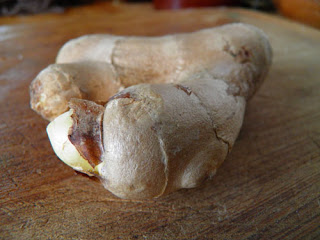
Ginger (Zingiber officinale)
Tinctured Ginger is effective against cholera bacteria. 1 dropperful 3 times daily for 7 days. If available, fresh ginger can be boiled for 10 minutes then allowed to steep for 1 hour. Strain the liquid and add to the rehydration fluids recipes.

Marshmallow root (Althea officinalis)
Cold infusions of marshmallow root can be drank to soothe the intestinal walls and irritations. Can also be given as an enema. As a mucilaginous herb, Marshmallow will help to absorb toxins and carry them out through the stools.
Berberine inhibits bacterial diarrhea caused by Vibrio cholera. Herbs such as Goldenseal (Hydrastis canadensis), Oregon Grape Root (Berberis aquifolium), Goldenthread (Coptis chinensis) and Barberry (Berberis vulgaris) should be taken daily for 3 – 5 days. Dosage should be 1 – 2 droppersful 2 times daily.

Clove (Syzygium aromaticum)
Place 1/4 ounce whole cloves in 3 quarts water and boil until only 1 1/2 quarts of water remain. Have the patient drink 1 cup throughout the day.
Chop 1 ounce of onion and place in a mortar and pestle with 7 black peppercorns. Thoroughly pound and feed to the patient.
Back To Eden by Jethro Kloss pgs. 345, 429 – 432

This entry was posted
on Monday, March 5th, 2012 at 3:22 pm and is filed under Uncategorized.
You can follow any responses to this entry through the RSS 2.0 feed.
You can leave a response, or trackback from your own site.

This is a project of mine, researching different common and uncommon diseases, illnesses and other health inflictions that couldn’t be easily treated during a long term crisis due to lack of medical assistance or medicine. This is not a replacement for medical advice, it is just my notes on how to cope with the situation using herbs if no medical help was available due to a long term crisis or other disaster scenario. It is intended for educational purposes only. All cases of smallpox should be assessed and treated by a medical provider.
It is an infectious disease caused by a virus. There are two variants of the virus, Variola major and Variola minor. V. major is the most common form of smallpox and is also the most severe.
Infections are highest during the winter and spring in temperate climates. Tropical climates can see infections throughout the year with few seasonal variations.
Smallpox is considered a ‘filth’ disease so making sure your community keeps clean can help to reduce the chances of outbreaks.
Smallpox looks similar to chickenpox and is often mistaken as chickenpox or vice versa.
Variola major has a mortality rate of 30% while V. minor has a mortality rate of 1%. It causes ulcerations of the cornea which can leave infected persons blind in one or both eyes. It can also leave severe scarring. There is no cure or conventional medication for smallpox. It can be spread by prolonged face-to-face contact as well as through direct contact with infected bodily fluids or contaminated items such as clothing and bedding linens.
During normal times, there is no treatment for the smallpox virus. Supportive care is given to control fever and pain. Fluids are also administered to prevent the patient from becoming dehydrated.
The patient should be quarantined and all linens and clothing should be washed in hot, soapy water with bleach to kill the virus. All infected surfaces should be washed with a bleach water solution.
The caregiver should wear a face mask and wash their hands with hot, soapy water after any contact with the patient or patients belongings.
Incubation Period: 7 – 17 days
During this time, infected people feel fine and do not show any symptoms. They are not contagious at this time.
Stage 2/Initial Symptoms: 2 – 4 days
The first symptoms include general malaise, fever, headaches and backaches, and sometimes vomiting. The fever will range between 101° to 104° F. The patient is possibly contagious at this point.
Stage 3/Early Rash: 3 – 4 days
A rash will first be seen as small red spots in the mouth and on the tongue. These spots will develop into sores that break open and spread large amounts of the virus into the mouth and throat. This is the most contagious phase of the virus.
When the sores in the mouth break down, a rash appears on the skin, beginning on the face and spreading down the arms and legs then to the outer extremities. They will often be present on the palms and soles. The rash usually spreads to all parts of the body within 24 hours. The fever usually starts to fall when the rash appears and the patient will start to feel better.
On day 3 the rash becomes raised bumps or pustules.
On day 4, the raised pustules fill with a thick, opaque fluid and the pustule will have a depression in the center, making the bumps look a bit like donuts.
The location of the rash and the shape of the pustules are both major indicators that the patient has smallpox and not chickenpox.
On day 4 the fever usually rises again and will remain high until the scabs for over the pustules.
The rash occurs at the same time during this period with the pustules on any part of the body remaining in the same stage of development.
Stage 4/Pustular Rash: 4 – 5 days
The pustules become sharply raised and round and often are described as feeling like there are bb pellets embedded in the skin. The patient is still contagious.
Stage 5/Scabbing: 4 – 5 days
The pustules begin to form a crust and then will scab over. About 14 days after the rash first appears most of the pustules will have scabbed over. The patient is still contagious.
Stage 6/Scabs Heal: 5 – 6 days
The scabs begin to heal and fall off. Marks will remain on the skin that may eventually become pitted scars. Scabs typically fall off 14 – 28 days after the rash begins. Once the scabs have completely fallen off the patient is no longer contagious.
There are many herbal remedies which will be beneficial for treating smallpox.
Keep the patient comfortable and avoid bright light since the eyes are weak at this time.
Keep the diet light and easy to digest so the body can concentrate on fighting the virus. Foods to feed the patient include:
Bone broth, vegetable broth
Congee (12 parts water: 1 part rice)
Natural juices both vegetable and fruit
Ripe fruits, especially pears and apples to help cleanse the bowels
Step 2: Encourage the Fever and perspiration
Giving diaphoretic herbs and hot baths will encourage rash to break out quicker and encourage faster healing. Give teas made from any diaphoretic herb available. Store teas in a thermos after making to keep them warm for administering as the patient needs them. Offer a continuous cup of tea for sipping and encourage them to drink often. Alternate with rehydration fluids to keep the patient from becoming dehydrated.
Do not attempt to suppress the fever or stop the pustule eruptions. Only use herbs to bring them out faster, encourage perspiration to flush the body and support the body as it works through the process.

Yarrow (Achillea millefolium)
Yarrow is specific for smallpox. May be combined with equal parts of Pleurisy root (Asclepias tuberosa) and Lady’s Slipper (Cypripedium acaule) for best results. If Lady’s slipper is not available, substitute Catnip (Nepeta cataria) or Valerian root (Valeriana officinalis).

Red Sage (Salvia miltiorrhiza)
Regular Sage (Salvia officinalis) may be effective if Red Sage is not available.
Do not give medications or herbs to suppress the rash and pustules from erupting, this is part of the body’s cleansing process. The larger the break out, the more toxins that will leave the body.

Step 3: Alleviate Itching
To soothe itching, wash pustules with either full strength lemon juice or a mixture of 50/50 apple cider vinegar and water.
Make a bath tea of Burdock root (Arctium spp.), Yellow Dock root (Rumex crispus) and/or Goldenseal root (Hydrastis canadensis) to relieve itching.
Step 4: Reduce Pitting/Scarring
Jethro Kloss suggests using a sterile needle to pop the pustules 4 days after they come to a head and washing them thoroughly with hydrogen peroxide to prevent pitting.
Goldenseal (Hydrastis canadensis)
Goldenseal is a specific to reduce pitting. Washes of Goldenseal root may be used to cleanse pustules as they burst. A salve made from Goldenseal root, fat and beeswax or even an oil of Goldenseal root and fat can be applied several times a day over the pustules to avoid much pitting.
Step 5: General Herbal Treatment
In addition to the above mentioned herbs, the following are various herbal treatments that have been used for treating smallpox. Use what you have available in your region.
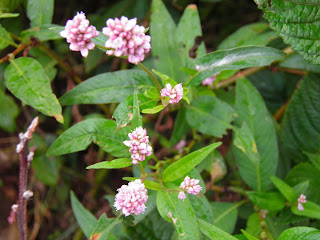
Bistort (Polygonurn bistorta)
Decoction of root is cleansing, astringent and toning.
Red Raspberry (Rubus idaeus)
Red Raspberry leaves can be mixed with Bistort for a toning and astringent tea.
European Pennyroyal (Mentha pulegium)
Do not confuse this with American Pennyroyal (Hedeoma pulegioides). European Pennyroyal has a warming influence for the stomach and is also diaphoretic and stimulating which is good for treating feverish conditions, bronchial congestion and eruptive diseases. Give 6 – 8 oz. infusion every 1 – 2 hours.

Chamomile (Matricaria recutita, M. discoidea)
Chamomile and Pineapple weed (also known as wild Chamomile, M. discoidea) are very soothing to the eyes and can help ease pain and inflammation of the eyes. Make a strong tea, soak some flannel cloth in the tea and drape over the closed eyes. It may be warm or cool, whichever the patient finds most soothing. The tea may also be used a was over the eyes. Be sure to strain all Chamomile plant material out first.

Tea or tincture from this plant can be soothing to the nerves, helping to calm an anxious patient. Catnip is also good for treating fever and can be used as an enema to help bring on perspiration. Catnip will also help to overcome the discomforts of smallpox. 1 cup of tea several times a day or 1 dropperful of tincture as needed.
Back To Eden by Jethro Kloss pgs. 369, 538

This entry was posted
on Monday, February 27th, 2012 at 3:17 pm and is filed under Uncategorized.
You can follow any responses to this entry through the RSS 2.0 feed.
You can leave a response, or trackback from your own site.
|
|































































